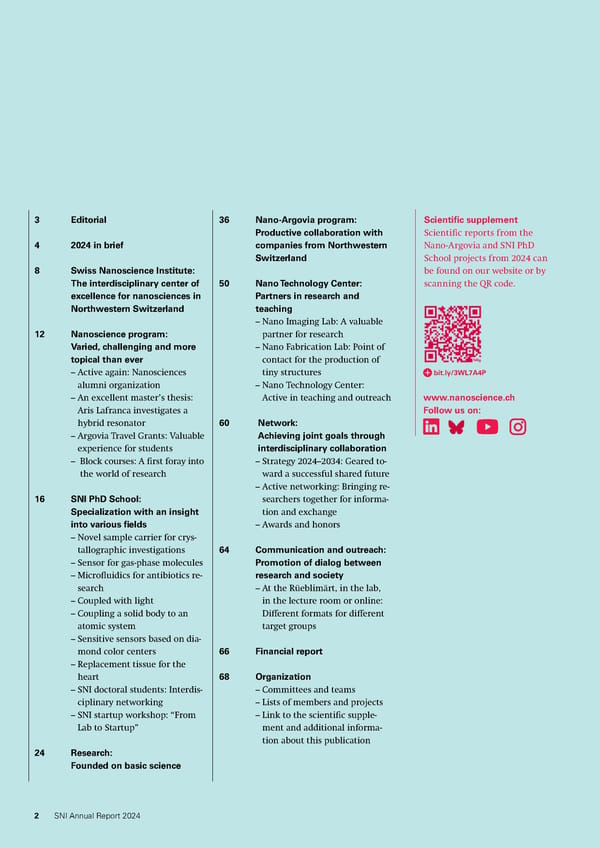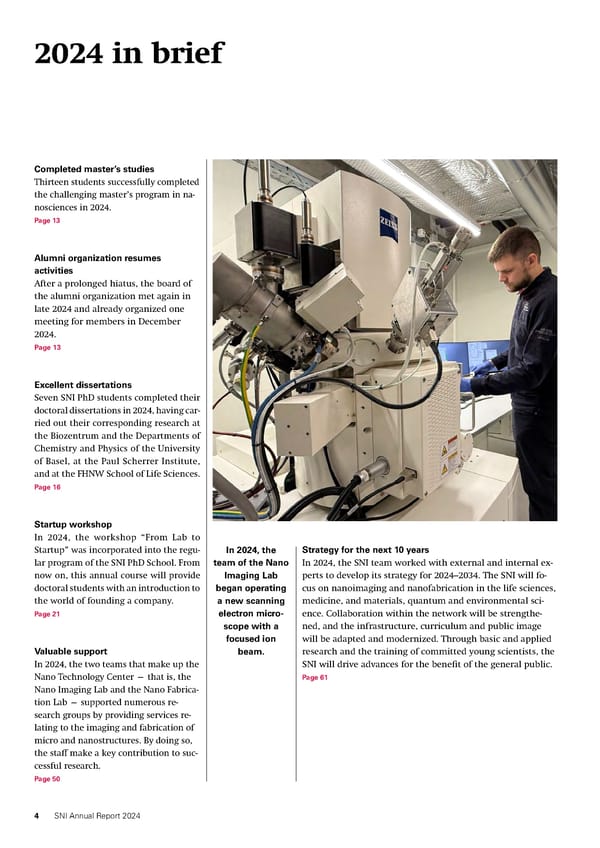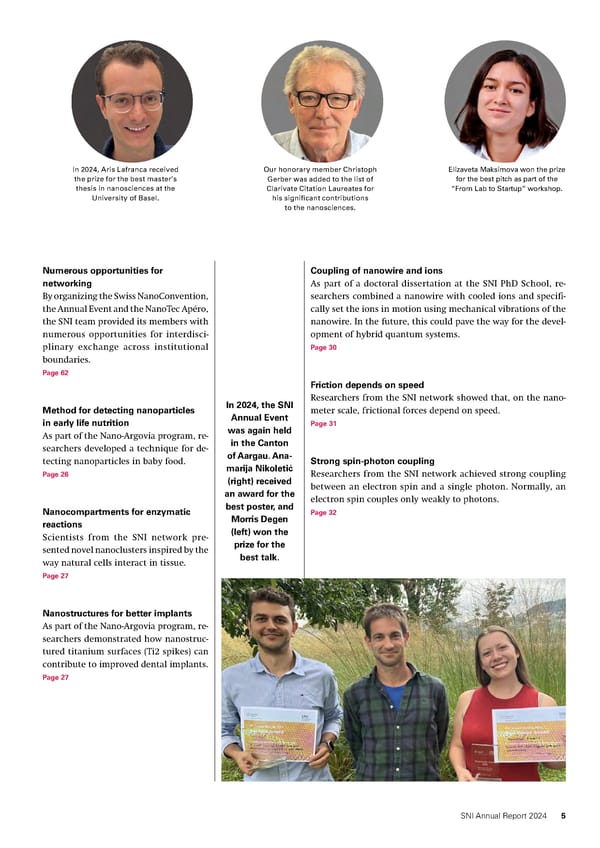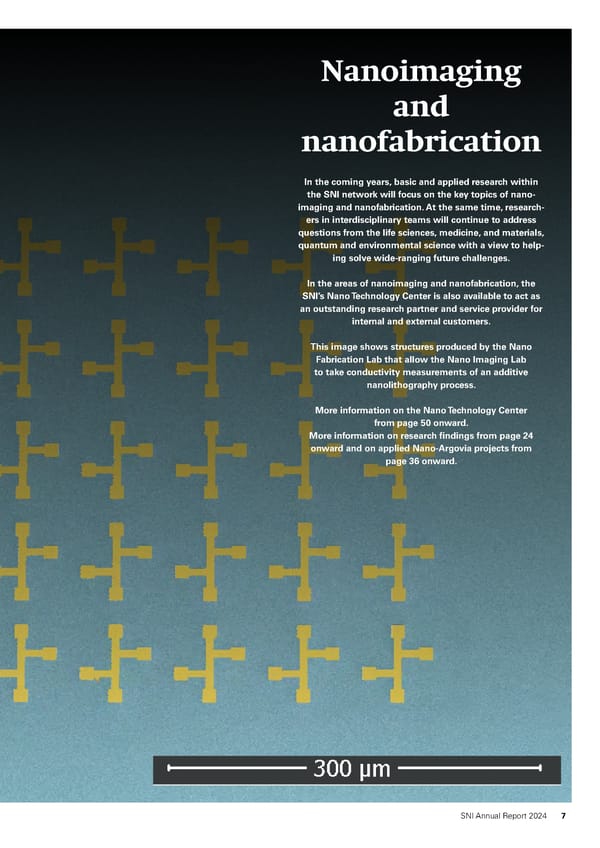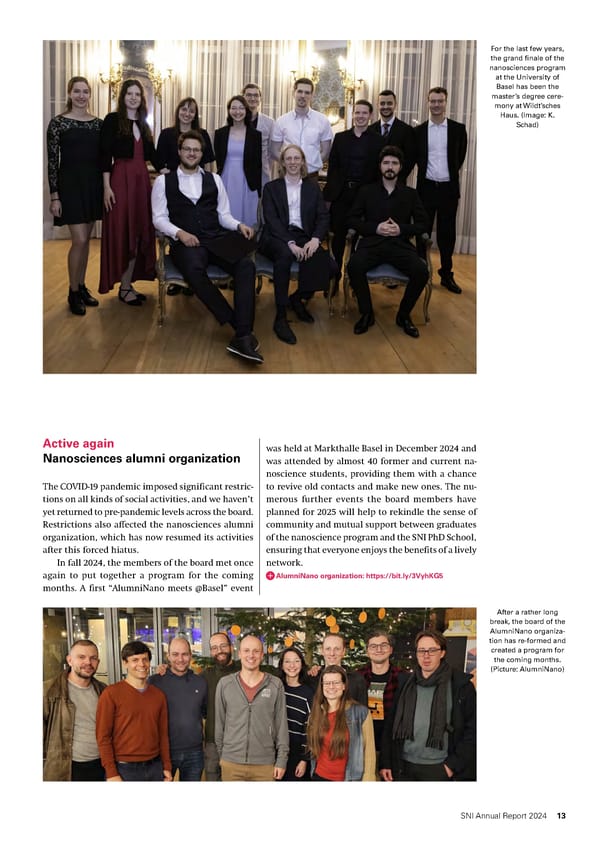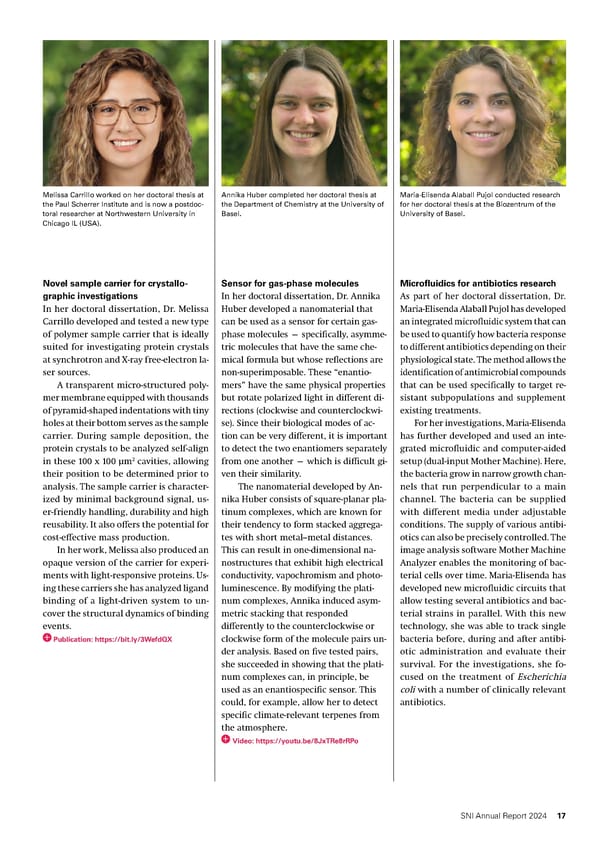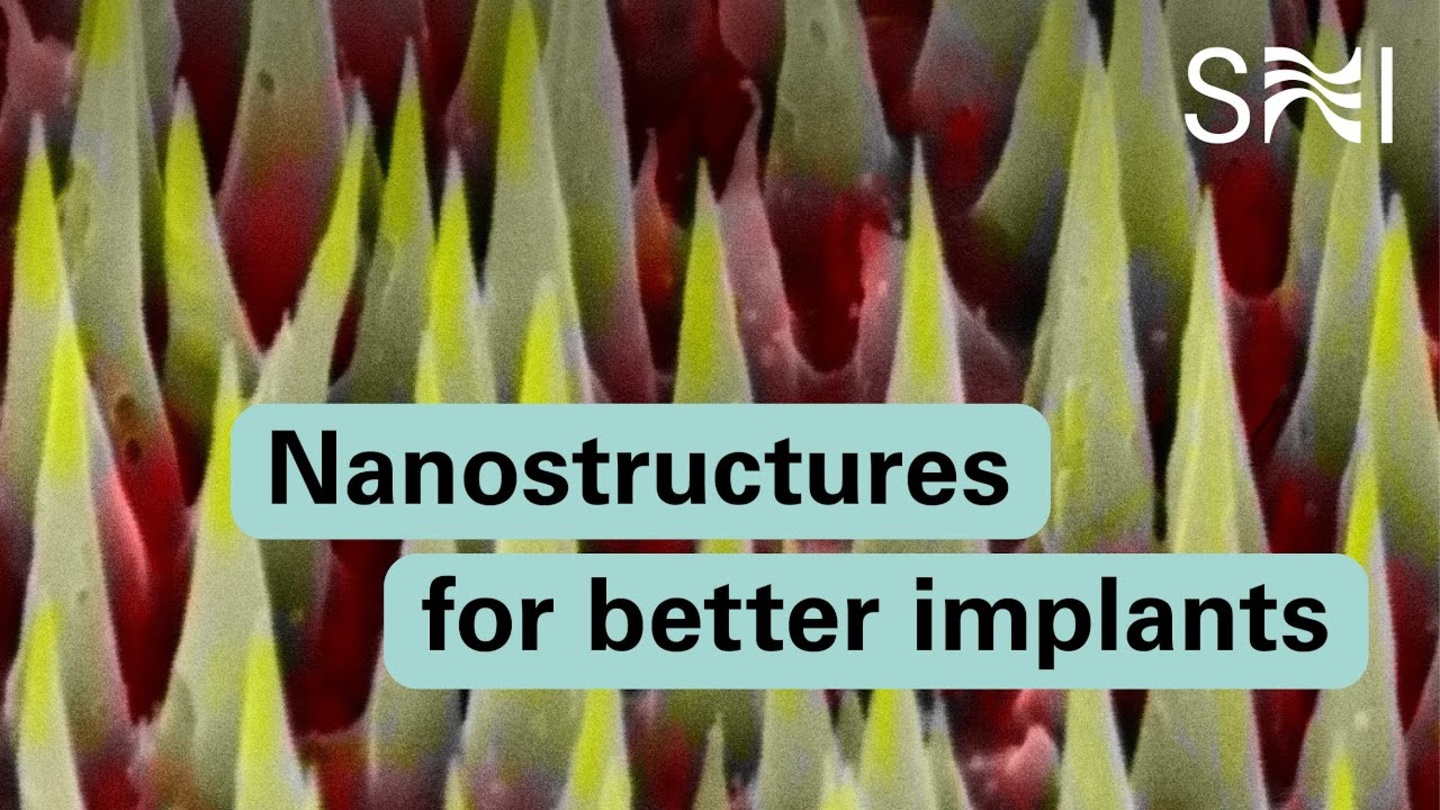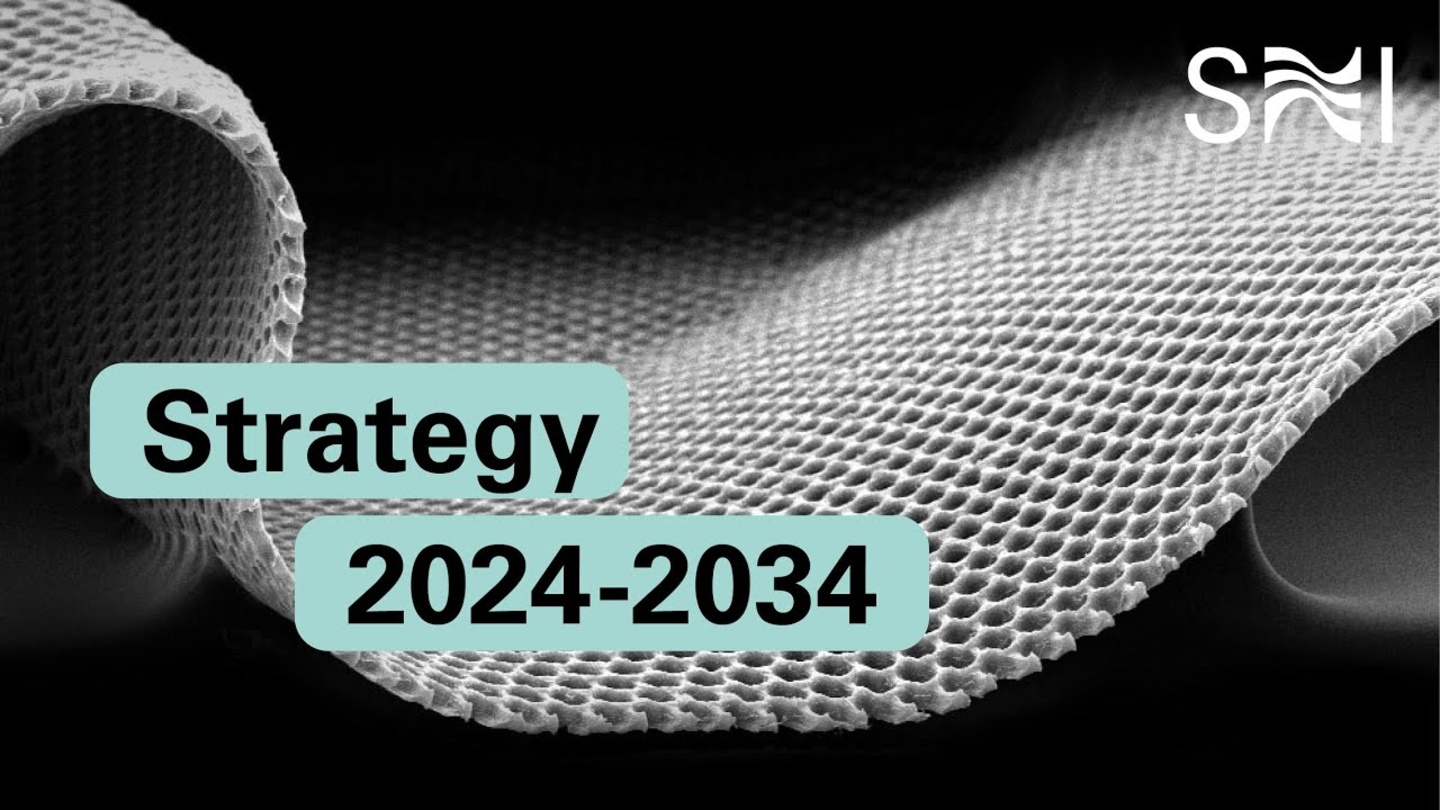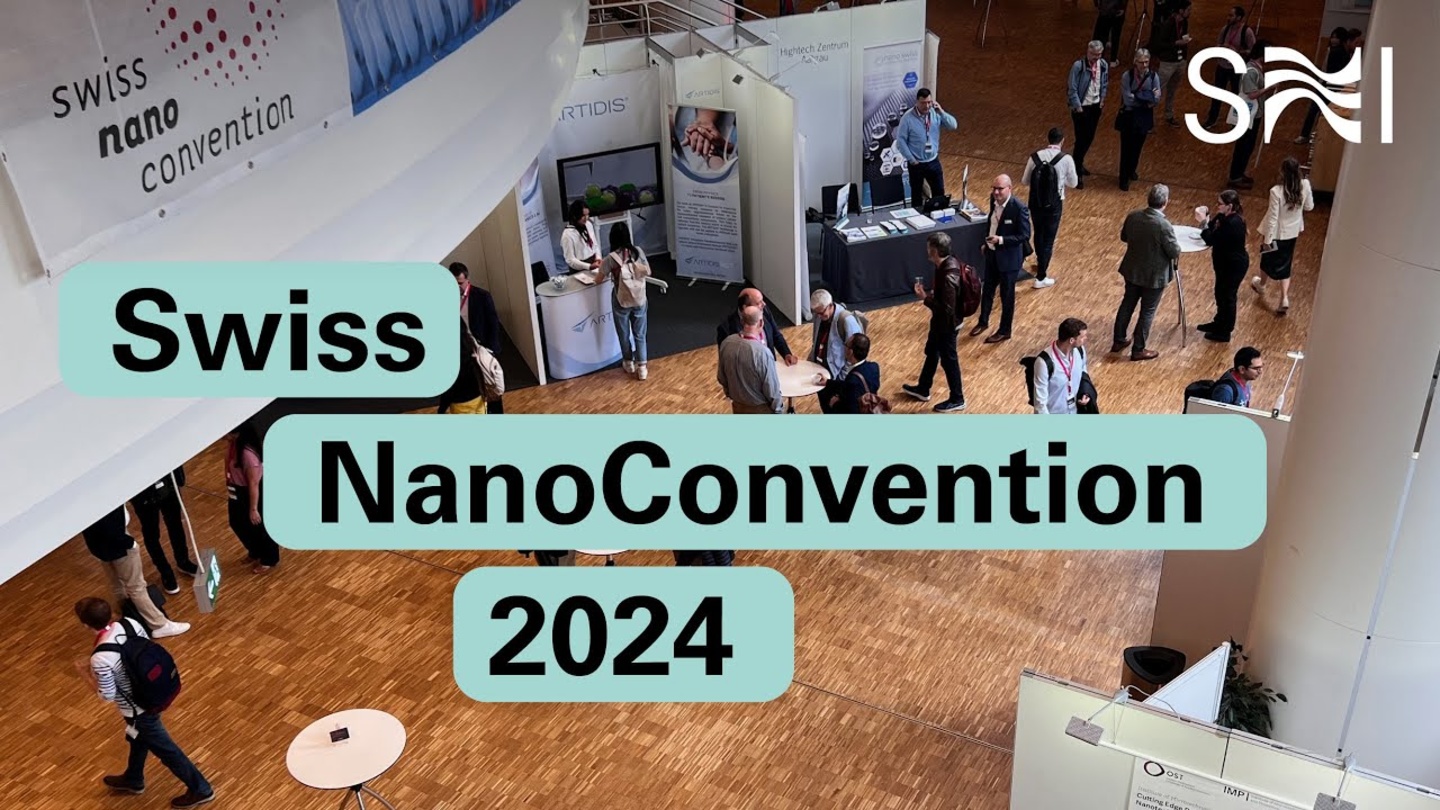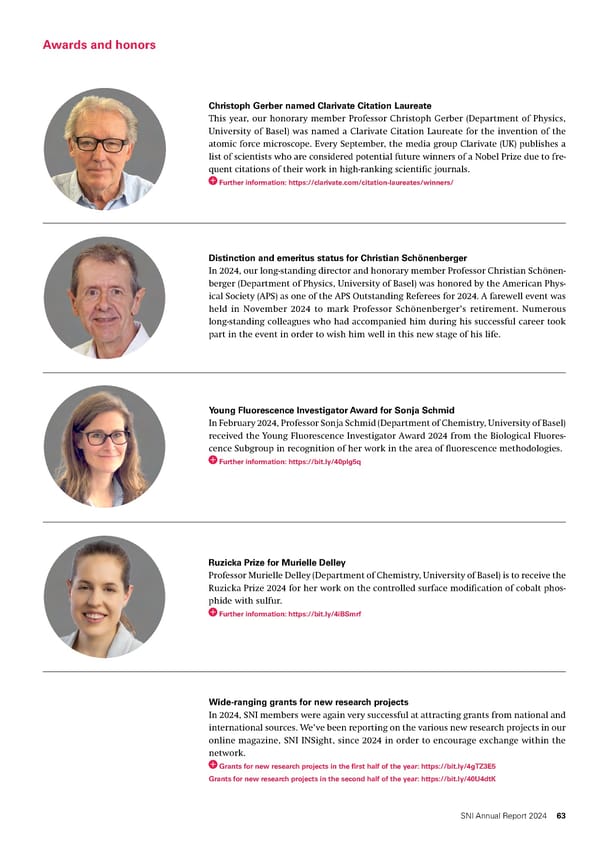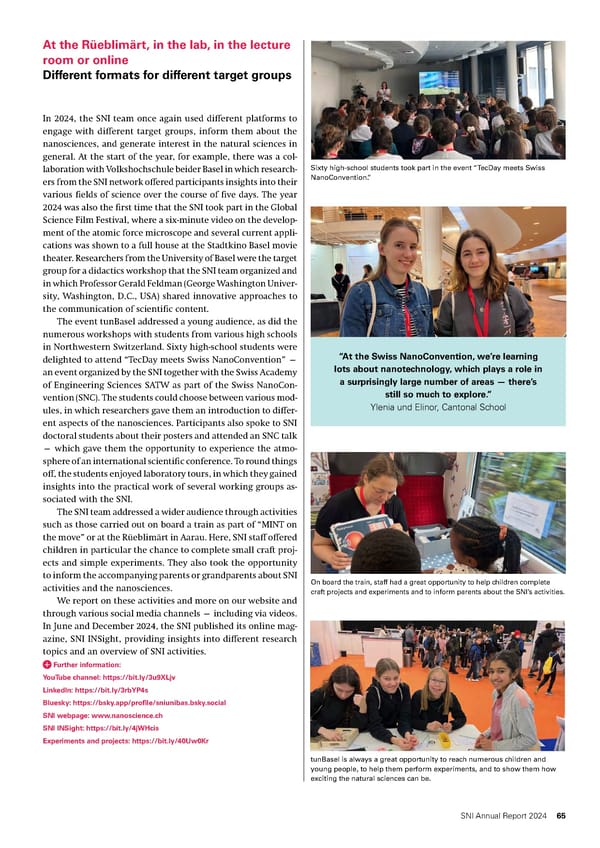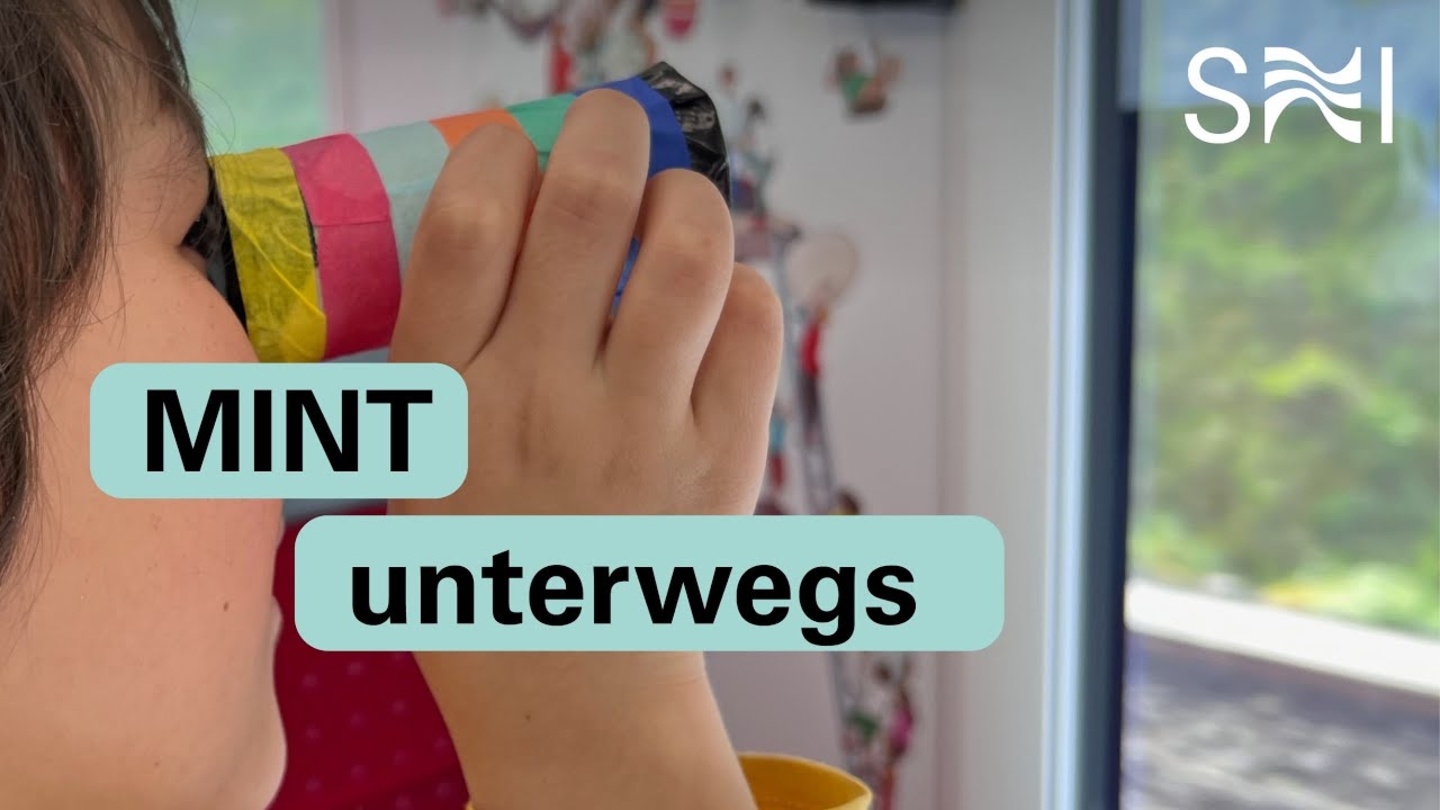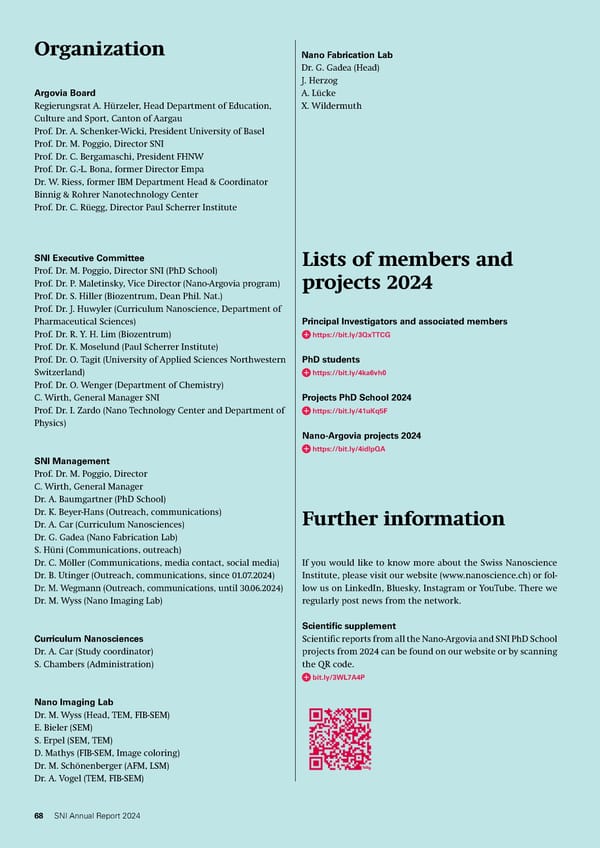Annual Report 2024 - Swiss Nanoscience Institute
Activities and results of the Swiss Nanoscience Institute in 2024
Annual Report Swiss Nanoscience Institute
3 Editorial 36 Nano-Argovia program: Scientific supplement Productive collaboration with Scientific reports from the 4 2024 in brief companies from Northwestern Nano-Argovia and SNI PhD Switzerland School projects from 2024 can 8 Swiss Nanoscience Institute: be found on our website or by The interdisciplinary center of 50 Nano Technology Center: scanning the QR code. excellence for nanosciences in Partners in research and Northwestern Switzerland teaching – Nano Imaging Lab: A valuable 12 Nanoscience program: partner for research Varied, challenging and more – Nano Fabrication Lab: Point of topical than ever contact for the production of – Active again: Nanosciences tiny structures bit.ly/3WL7A4P alumni organization – Nano Technology Center: – An excellent master’s thesis: Active in teaching and outreach www.nanoscience.ch Aris Lafranca investigates a Follow us on: hybrid resonator 60 Network: – Argovia Travel Grants: Valuable Achieving joint goals through experience for students interdisciplinary collaboration – Block courses: A first foray into – Strategy 2024–2034: Geared to- the world of research ward a successful shared future – Active networking: Bringing re- 16 SNI PhD School: searchers together for informa- Specialization with an insight tion and exchange into various fields – Awards and honors – Novel sample carrier for crys- tallographic investigations 64 Communication and outreach: – Sensor for gas-phase molecules Promotion of dialog between – Microfluidics for antibiotics re- research and society search – At the Rüeblimärt, in the lab, – Coupled with light in the lecture room or online: – Coupling a solid body to an Different formats for different atomic system target groups – Sensitive sensors based on dia- mond color centers 66 Financial report – Replacement tissue for the heart 68 Organization – SNI doctoral students: Interdis- – Committees and teams ciplinary networking – Lists of members and projects – SNI startup workshop: “From – Link to the scientific supple- Lab to Startup” ment and additional informa- tion about this publication 24 Research: Founded on basic science 2 SNI Annual Report 2024
Dear colleagues and nanoenthusiasts, In the Annual Report 2024 that you have searchers have tackled problems in the that together make the SNI a unique in- before you, we look back over a busy year life sciences, medicine, and environmen- terdisciplinary, interinstitutional net- that was full of fascinating research find- tal, materials and quantum science — that work with shared objectives. ings and events that provided opportuni- is, in precisely the areas where we want For those who want more informa- ties for inspirational encounters. It was to continue making valuable contribu- tion, the scientific supplement offers also a year in which we continued to tions in the future by visualizing and man- more-detailed descriptions of projects think intensively about the future of the ufacturing tiny structures and objects. supported as part of the SNI PhD School Swiss Nanoscience Institute as we pre- The Nano Imaging Lab and Nano Fab- and the applied Nano-Argovia program in pared the final draft of the strategy paper rication Lab are the two service units that 2024. for 2024–2034. To this end, we not only together make up the Nano Technology sought the advice of external experts but Center. These two units contribute to the We hope you enjoy reading this year’s re- also took up ideas and proposals from SNI’s success not only through their ser- port. within the SNI network. In May 2024, the vices but also through research of their paper was then approved by our highest own. Over the coming years, the two body, the Argovia Committee. Accord- teams will play an increasingly vital role Kind regards, ingly, it will now serve as a guide and help within our network and act as a link be- us fulfill our vision of using nanotechnol- tween researchers. Work relating to ogy to improve lives. As the network for nanoimaging and nanofabrication is not nanosciences in Switzerland, we are keen only of interest to scientists. Indeed, an to help tackle the challenges of the future ever-broader audience enjoys fascinating through education and research. Our fo- insights into the micro and nanoworld cus will be on nanoimaging and nanofab- courtesy of the staff of the Nano Technol- Professor Martino Poggio rication and on bolstering collaboration ogy Center. SNI Director within the network. We will make sensi- Our small, dedicated communication ble and necessary adjustments on an on- and outreach team also generates inter- going basis and help solve the challenges est in the natural sciences in general and facing society through our activities in the nanosciences in particular on an on- the areas of teaching, research, technol- going basis with the help of various ogy transfer and services. events, such as the hugely successful In the first section of the annual re- “TecDay meets Swiss NanoConvention” port, we showcase selected highlights in in 2024. For this event, which formed terms of education within the nanosci- part of the Swiss NanoConvention orga- ences degree program and at the SNI PhD nized by the SNI in Basel, our team School before taking a closer look at re- worked with the Swiss Academy of Engi- search findings. Here, we offer examples neering Sciences SATW to compile a spe- of the fields where members of the SNI cial program for 60 students from Swiss network have published their results in high schools. The program provided the renowned scientific journals. We also pro- students with an introduction to the na- vide short and succinct descriptions of nosciences as well as a chance to experi- applied research projects funded by the ence the exciting atmosphere of an inter- SNI as part of the Nano-Argovia program national scientific conference. in 2024. In this context, it’s always fasci- This annual report provides further nating to see the diverse approaches ad- information on all of our activities. For opted by nanoscience research in its mis- example, a series of images offer insights sion to deliver solutions. This year, re- into the work of various working groups SNI Annual Report 2024 3
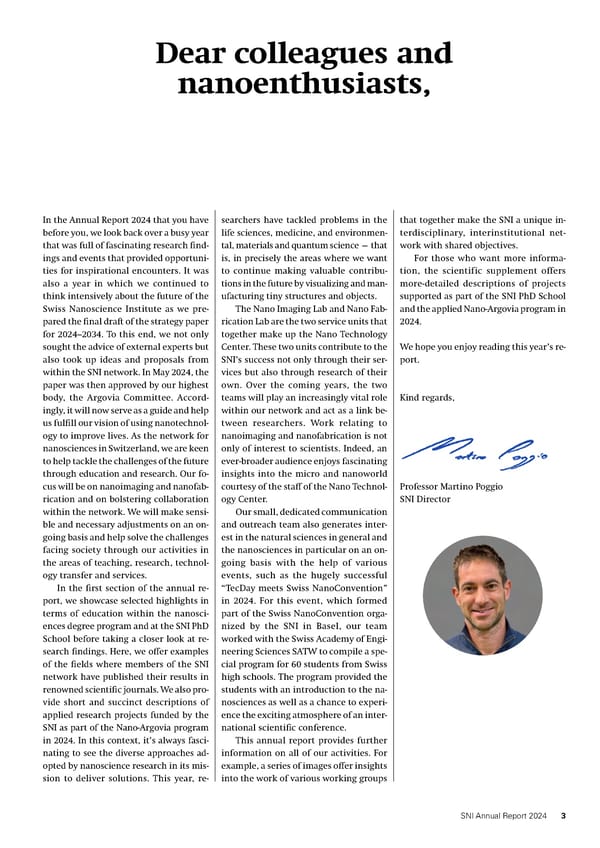
2024 in brief Completed master’s studies Thirteen students successfully completed the challenging master’s program in na- nosciences in 2024. Page 13 Alumni organization resumes activities After a prolonged hiatus, the board of the alumni organization met again in late 2024 and already organized one meeting for members in December 2024. Page 13 Excellent dissertations Seven SNI PhD students completed their doctoral dissertations in 2024, having car- ried out their corresponding research at the Biozentrum and the Departments of Chemistry and Physics of the University of Basel, at the Paul Scherrer Institute, and at the FHNW School of Life Sciences. Page 16 Startup workshop In 2024, the workshop “From Lab to Startup” was incorporated into the regu- In 2024, the Strategy for the next 10 years lar program of the SNI PhD School. From team of the Nano In 2024, the SNI team worked with external and internal ex- now on, this annual course will provide Imaging Lab perts to develop its strategy for 2024–2034. The SNI will fo- doctoral students with an introduction to began operating cus on nanoimaging and nanofabrication in the life sciences, the world of founding a company. a new scanning medicine, and materials, quantum and environmental sci- Page 21 electron micro- ence. Collaboration within the network will be strengthe- scope with a ned, and the infrastructure, curriculum and public image focused ion will be adapted and modernized. Through basic and applied Valuable support beam. research and the training of committed young scientists, the In 2024, the two teams that make up the SNI will drive advances for the benefit of the general public. Nano Technology Center — that is, the Page 61 Nano Imaging Lab and the Nano Fabrica- tion Lab — supported numerous re- search groups by providing services re- lating to the imaging and fabrication of micro and nanostructures. By doing so, the staff make a key contribution to suc- cessful research. Page 50 4 SNI Annual Report 2024
In 2024, Aris Lafranca received Our honorary member Christoph Elizaveta Maksimova won the prize the prize for the best master’s Gerber was added to the list of for the best pitch as part of the thesis in nanosciences at the Clarivate Citation Laureates for “From Lab to Startup” workshop. University of Basel. his significant contributions to the nanosciences. Numerous opportunities for Coupling of nanowire and ions networking As part of a doctoral dissertation at the SNI PhD School, re- By organizing the Swiss NanoConvention, searchers combined a nanowire with cooled ions and specifi- the Annual Event and the NanoTec Apéro, cally set the ions in motion using mechanical vibrations of the the SNI team provided its members with nanowire. In the future, this could pave the way for the devel- numerous opportunities for interdisci- opment of hybrid quantum systems. plinary exchange across institutional Page 30 boundaries. Page 62 Friction depends on speed In 2024, the SNI Researchers from the SNI network showed that, on the nano- Method for detecting nanoparticles Annual Event meter scale, frictional forces depend on speed. in early life nutrition was again held Page 31 As part of the Nano-Argovia program, re- in the Canton searchers developed a technique for de- of Aargau. Ana- tecting nanoparticles in baby food. marija Nikoletić Strong spin-photon coupling Page 26 (right) received Researchers from the SNI network achieved strong coupling an award for the between an electron spin and a single photon. Normally, an best poster, and electron spin couples only weakly to photons. Nanocompartments for enzymatic Morris Degen Page 32 reactions (left) won the Scientists from the SNI network pre- prize for the sented novel nanoclusters inspired by the best talk. way natural cells interact in tissue. Page 27 Nanostructures for better implants As part of the Nano-Argovia program, re- searchers demonstrated how nanostruc- tured titanium surfaces (Ti2 spikes) can contribute to improved dental implants. Page 27 SNI Annual Report 2024 5
6 SNI Annual Report 2024
Nanoimaging and nanofabrication In the coming years, basic and applied research within the SNI network will focus on the key topics of nano- imaging and nanofabrication. At the same time, research- ers in interdisciplinary teams will continue to address questions from the life sciences, medicine, and materials, quantum and environmental science with a view to help- ing solve wide-ranging future challenges. In the areas of nanoimaging and nanofabrication, the SNI’s Nano Technology Center is also available to act as an outstanding research partner and service provider for internal and external customers. This image shows structures produced by the Nano Fabrication Lab that allow the Nano Imaging Lab to take conductivity measurements of an additive nanolithography process. More information on the Nano Technology Center from page 50 onward. More information on research findings from page 24 onward and on applied Nano-Argovia projects from page 36 onward. SNI Annual Report 2024 7
Swiss Nanoscience Institute: The interdisciplinary center of excellence for nanosciences in Northwestern Switzerland The Swiss Nanoscience Institute (SNI) was founded in 2006 by the Canton of Aargau and the University of Basel and brings together researchers from lead- ing scientific institutions from Northwestern Swit- zerland that are dedicated to questions of both ba- 24% sic and applied science. At the same time, the SNI plays an active role in training young scientists in or 24% of SNI members - are women. der to ensure that the experts of the future are ide- ally prepared to tackle interdisciplinary challenges. Key to this intensive commitment is Switzerland’s only nanoscience degree program, which leads students to a bachelor’s and master’s degree in 11+13+7 nanosciences at the University of Basel. The SNI also operates an international PhD School, which In 2024, eleven students successfully attracts talented early career researchers from completed their bachelor’s program, thirteen completed the master’s pro- across the world. gram. Seven doctoral students success- fully defended their PhD theses. Research and teaching are supported by the Nano Technology Center, which provides academic and industrial partners with expertise in the areas of imaging, analysis and micro and nanofabrication through the two service units — the Nano Imaging Lab and the Nano Fabrication Lab. In the future, the SNI will increasingly orient its re- search activities toward the areas of nanoimaging 40 and nanofabrication. Through close collaboration within the network, the SNI will help to tackle In 2024, 40 doctoral students were enrolled in the SNI PhD School. pressing challenges in the life sciences, medicine, and quantum, materials and environmental science . 8 SNI Annual Report 2024
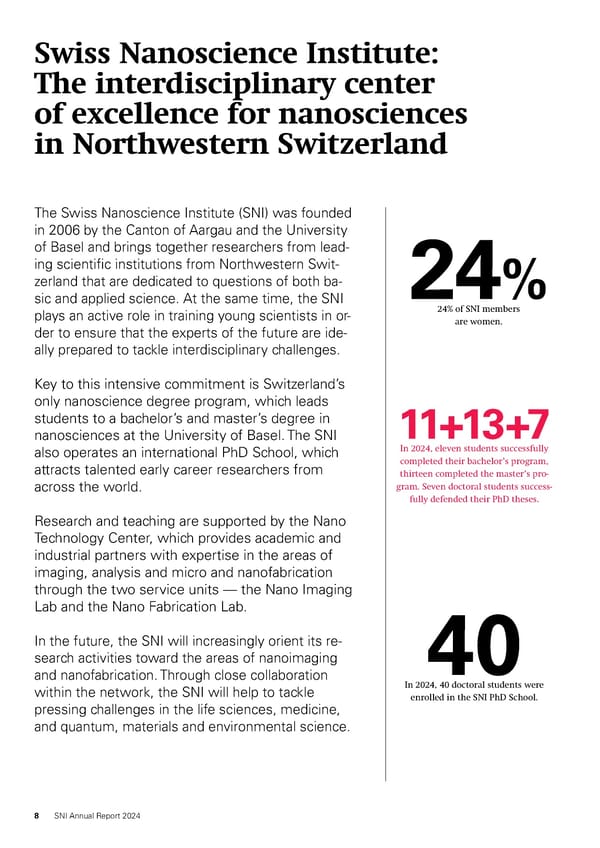
173 173 members belong to the SNI network. (PIs, PhD students, management, Nano Fabrication Lab, and Nano Imaging Lab). 10 There are ten partner institutions in the SNI network. These include the research institutions University of Basel, the School of Life Sciences and the School of Engineering and Environ- ment at the University of Applied Scien- 17 ces and Arts Northwestern Switzerland Seventeen of the 60 doctoral students FHNW, the Paul Scherrer Institute PSI, who had completed their PhDs by the the Centre Suisse d`Electronique et de end of 2024 work at a federal or Microtechnique (CSEM) in Allschwil, research institution. the Department of Biosystems Science and Engineering at the ETH Zurich 50 in Basel, and the technology transfer In 2024, 50 research projects were run- centers ANAXAM and Swiss PIC. The ning, 10 in the applied Nano-Argovia network also includes the Hightech Program and 40 in the SNI PhD School. Zentrum Aargau and Basel Area Business & Innovation. 40 8.9 M Forty of the 60 doctoral students who In 2024, the SNI had expenditures of had completed their PhDs by the end of approximately CHF 8.9 million (without 2024 work in industry. building costs) of which CHF 5.8 million were covered by the Canton of Aargau 76 and CHF 3.1 million by the In 2024, 52 students were enrolled in the University of Basel. bachelor’s program and 24 in the mas- ter’s program. 74 73+130 In 2024, a total of 74 peer-reviewed In 2024, the Nano Fabrication Labs had papers with participation of SNI 73 different users. The Nano Imaging members were published in renowned Lab received more than 180 orders, science journals. >7000 which often take several days, from 130 . The SNI social media channels on different customers. Instagram, LinkedIn, X, Bluesky and You- Tube have more than 7000 followers. SNI Annual Report 2024 9
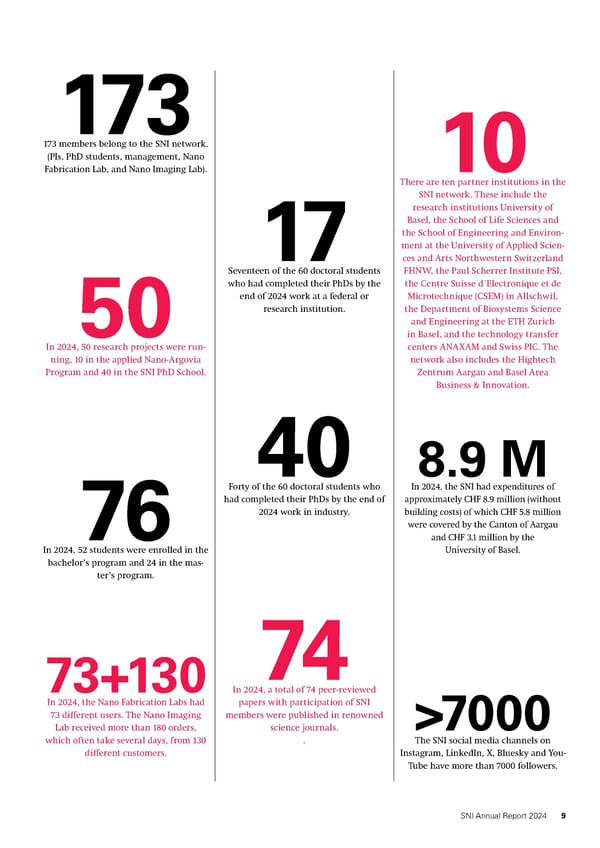
The SNI is funded Rooted in the Canton of Aargau and mer nanoscience students at the University of Basel by the Canton the University of Basel go on to complete their dissertation at the SNI PhD of Aargau and The SNI was founded in 2006 by the Canton of Aargau School, which was founded in 2012, but most of the the University and the University of Basel in order to drive forward 40 doctoral students who formed part of the SNI PhD of Basel. research and training in the nanosciences and nano- School in 2024 had completed their previous educa- technology in Northwestern Switzerland. In the com- tion at foreign universities. The students generally ing years, the plan is to focus on nanoimaging and work on questions of basic research, which are often nanofabrication with a view to contributing to new interdisciplinary in nature. Seven doctoral students insights and innovations in the life sciences, medi- successfully completed their dissertation in 2024, cine, and quantum, materials and environmental while six new projects were approved and will start science. in 2025. Over 70% of the 60 graduates of the SNI PhD Nanotechnologies play a key role in research and School remain in Switzerland after completing their industry in the Canton of Aargau. The SNI’s numer- dissertation. ous research projects provide companies from Aar- gau, Solothurn and the two Basel half-cantons with access to new scientific findings and innovative tech- Support for research groups nologies and services. The two SNI-supported Argovia professors Roderick In 2024, the SNI spent approximately 8.9 million Lim and Martino Poggio are very active in training Swiss francs, of which some 5.8 million were pro- and in their respective areas of research with their vided by the Canton of Aargau and 3.1 million by the research groups at the University of Basel. Through University of Basel. their work on cellular transport processes and nano- mechanics and nanomagnetism, respectively, they make a significant contribution to the SNI’s outstand- Interdisciplinary network ing reputation. In addition, the SNI funds the re- The SNI interconnects researchers from leading sci- search of the three titular professors Thomas Jung, entific institutions in Northwestern Switzerland, Michel Kenzelmann and Frithjof Nolting, who lecture including various departments of the University of at the Department of Physics of the University of Ba- Basel; the University of Applied Sciences Northwest- sel and are active with their research groups at PSI. ern Switzerland, with its School of Life Sciences in The SNI brings Muttenz and School of Engineering and Environ- together ment in Windisch; the Paul Scherrer Institute PSI; Technology transfer and industrial collaborations researchers from the Department of Biosystems Science and Engineer- The SNI supports knowledge and technology transfer the leading scien- ing at ETH Zurich in Basel; the Centre Suisse d’Elec- through the Nano-Argovia program, in which around tific institutions tronique et de Microtechnique (CSEM) in Allschwil; 100 projects have already been carried out in collab- of Northwestern and the two technology transfer centers ANAXAM oration with companies from Northwestern Switzer- Switzerland. and Swiss PIC. The SNI also engages in collaborations land. In 2024, 10 of these applied research projects with the Hightech Zentrum Aargau in Brugg and received financial support. Six of the partner com- with Basel Area Business & Innovation in relation to panies hailed from the Canton of Aargau, while four knowledge and technology transfer. were based in one of the two Basel half-cantons. Col- laboration with industry is also supported by the two technology transfer centers ANAXAM and Swiss PIC, Education and career advancement which are also partners in the SNI network. In the bachelor’s and master’s program in nano- sciences at the University of Basel, students receive a comprehensive grounding in the natural sciences Highly qualified services from the Nano before specializing in individual focal areas. From Technology Center an early stage, the students gain practical experience The SNI’s Nano Technology Center provides special- Providing train- in research groups and familiarize themselves with ized services to research and industry through its ing and support industrial projects. two groups — the Nano Imaging Lab (NI Lab) and the for early career So far, a total of 296 students have earned a bach- Nano Fabrication Lab (NF Lab). In the NI Lab, the researchers is elor’s degree in nanosciences in Basel, and 229 stu- six-person team specializes in surface imaging and one of the key dents have successfully completed the nanosciences analysis, while the four members of the NF Lab pro- tasks of the SNI. master’s program. At the end of 2024, there were 52 vide access to extensive instrumentation and clean students enrolled on the bachelor’s program and 24 rooms, offering researchers within the network and early career researchers enrolled on the master’s beyond the opportunity to produce tiny structures program. on the micro and nanoscale. For many young nanoscientists, the master’s de- gree is followed by a doctoral dissertation. Some for- 10 SNI Annual Report 2024
The interdisciplinary network of the SNI is made up of research groups from the leading research institutions in Northwestern Switzerland. These research groups work on basic and applied re- search projects, ensure an excellent standard of research work, and are committed to the training of early career researchers. (Background image: iStock) In the focal areas Public relations and science communication formation in the form of videos, brochures, media of nanoimaging It’s important to the SNI team not only to train young releases and an online magazine that reach the dif- and nanofabrica- scientists, conduct excellent research and act as a ferent target groups via various social media chan- tion, the Nano sought-after partner and service provider, but also nels. Technology Cen- to inform the general public about SNI activities and ter acts as a foster an interest in the natural sciences. service unit and As part of science festivals, exhibitions and mar- research partner, kets, as well as through laboratory tours and collab- providing valu- orations with adult education centers or other insti- able support for tutions, SNI staff seek to engage with various target wide-ranging groups. Through individual formats, which are al- research projects. most always associated with interactive activities, the SNI team opens the door to the world of tiny structures and objects, generating interest in nano- research. The communication team also collates in- SNI Annual Report 2024 11
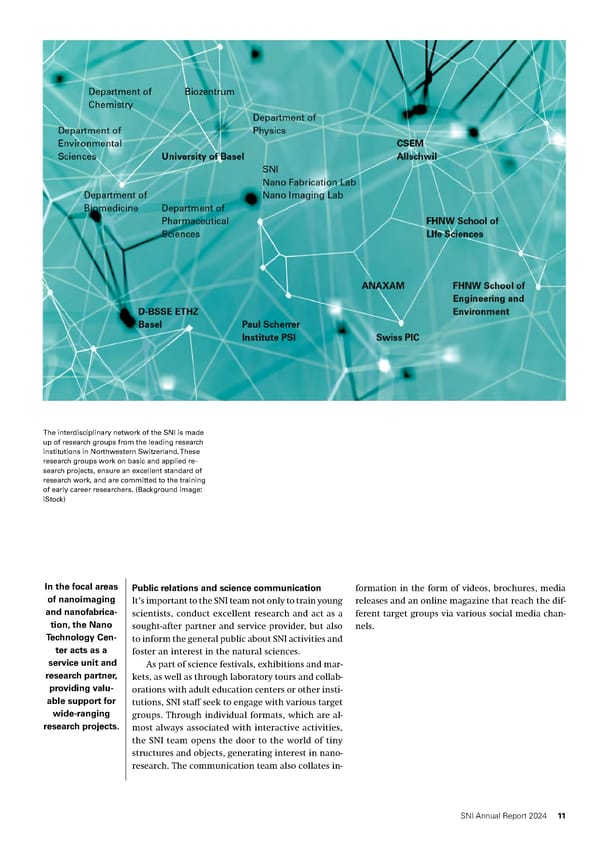
Nanoscience program: Varied, challenging and more topical than ever Aspects of the nanosciences feature in interdisciplinary fields such as the life sciences, materials, environmental and quantum sciences, as well as medicine. Studying nanosciences at the University of Basel leaves students ideally prepared to handle wide-ranging tasks in these and other disciplines, equipping them to solve the challenges that will face our society in the future. In the introductory level, students gain a solid grounding in the natu- ral sciences, which they then consolidate as they become increasing- ly specialized over the course of their bachelor’s and master’s studies. To that end, the young scientists choose two from the following spe - cializations as part of the master’s program: medical nanosciences, molecular biology, nanochemistry and nanophysics. At the same time, students continue to benefit from the interdisciplinary nature of the degree program, providing them with insights into wide-ranging re - search problems and methodology. This teaches budding researchers the “languages” of various disciplines and provides them with the ideal tools to work at the interface between different subject areas. In 2024, there were 52 students enrolled on the bachelor’s program and 24 on the master’s program. Eleven students successfully com- pleted their bachelor’s studies, and 13 obtained a master’s degree. 12 SNI Annual Report 2024
For the last few years, the grand finale of the nanosciences program at the University of Basel has been the master’s degree cere- mony at Wildt’sches Haus. (Image: K. Schad) Active again was held at Markthalle Basel in December 2024 and Nanosciences alumni organization was attended by almost 40 former and current na- noscience students, providing them with a chance The COVID-19 pandemic imposed significant restric- to revive old contacts and make new ones. The nu- tions on all kinds of social activities, and we haven’t merous further events the board members have yet returned to pre-pandemic levels across the board. planned for 2025 will help to rekindle the sense of Restrictions also affected the nanosciences alumni community and mutual support between graduates organization, which has now resumed its activities of the nanoscience program and the SNI PhD School, after this forced hiatus. ensuring that everyone enjoys the benefits of a lively In fall 2024, the members of the board met once network. again to put together a program for the coming AlumniNano organization: https://bit.ly/3VyhKG5 months. A first “AlumniNano meets @Basel” event After a rather long break, the board of the AlumniNano organiza- tion has re-formed and created a program for the coming months. (Picture: AlumniNano) SNI Annual Report 2024 13
An excellent master’s thesis Argovia Travel Grants worked at the Department of Biomaterials Aris Lafranca investigates Valuable experience for & Biomedical Technology and the Euro- a hybrid resonator students pean Research Institute for the Biology of Ageing at University Medical Center Gron- In 2024, Aris Lafranca received the prize Nanoscience students can apply for Argo- ingen (NL) and at the Department of Chem- for the best master’s thesis in nanosci- via Travel Grants if they are planning to ical Engineering and Biotechnology at the ences at the University of Basel. As part complete project work or a master’s thesis University of Cambridge (UK). One mas- of his winning thesis at the Department abroad. Spending time in an international ter’s student is still working at the Insti- of Physics, the young nanoscientist from research environment gives them access tute for Technology-Inspired Regenerative Ticino investigated a hybrid resonator in to highly specialized laboratories, technol- Medicine of the University of Maastricht greater detail. Made of hexagonal boron ogies and research groups that comple- (NL) and will complete her master’s degree nitride and a silicon nitride membrane, ment the opportunities on offer in Basel. in 2025. this resonator could potentially be used Students familiarize themselves with new Reports from students on their time abroad: to measure forces, masses or accelera- methods and start to build up a global sci- https://bit.ly/3Jss64m tion, as well as for biomedical applica- entific network, gaining international ex- tions. Lafranca’s investigations sought to perience that not only drives their aca- better characterize the system and to demic development but also boosts per- monitor and control the influence of tem- sonal skills such as adaptability, intercul- perature. tural communication and independence. Report on Aris Lafranca’s master’s thesis: In 2024, four students benefited from “During my time in Cambridge, https://bit.ly/4grLNGh the offer of financial aid in the form of I was able to practice and im- Video with Aris Lafranca: Argovia Travel Grants. Three of them have prove my skills in the areas of https://youtu.be/UhcM43AK-7s since completed their projects, having scientific planning, discussion and criticism, as well as inter- personal communication. I also benefited from a highly sup- “Aris’ thesis is without a doubt “I’m grateful to the Swiss portive and motivational work- the best and most expertly Nanoscience Institute and ing environment, which gave executed master’ thesis I have Professor Santos for this amaz- me the opportunity to build read here in Basel. ing opportunity. As well as friendships with people from all I am very pleased that he has gaining knowledge and practi- over the world and expand my decided to continue working in cal experience, I discovered scientific network.” experimental physics as a PhD new avenues of professional Michelle Arnet, a former nanosci- student in my group.” and personal development — ence student who completed her Prof. Martino Poggio, and had a great time in Gronin- master’s thesis at the Depart- Department of Physics, gen, both inside and outside ment of Chemical Engineering University of Basel the laboratory.” and Biotechnology at the Univer- Alexa Dani, a former nanoscience sity of Cambridge (UK) and is now student who wrote her master’s doing a doctorate at the German thesis at University Medical Cen- Cancer Research Center in Hei- ter Groningen in the Netherlands delberg (Germany) and now works at Roche in Basel 14 SNI Annual Report 2024
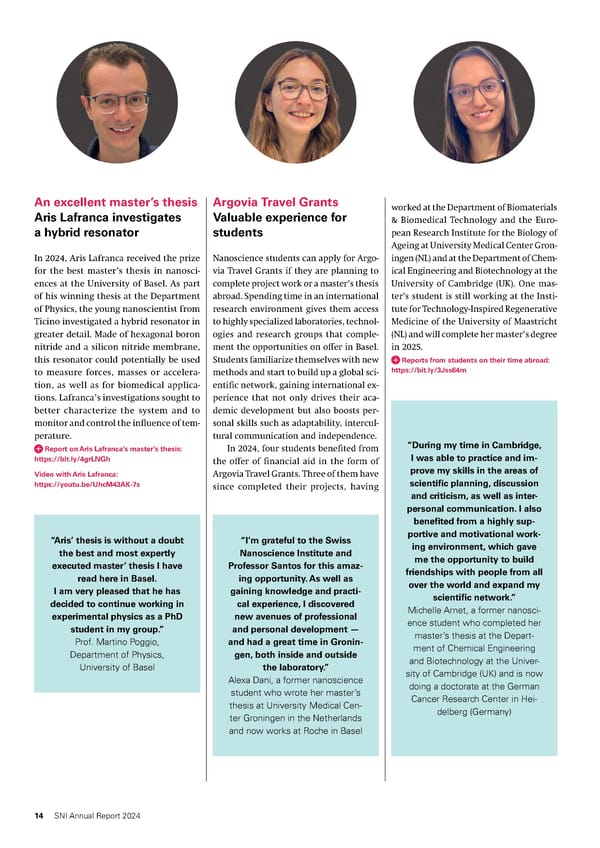
Block courses Students carry out small projects of their own within A first foray into the world of research the framework of the block courses. This provides them with an insight into current research at various departments of the University of Basel and other re- In the fifth and sixth semesters of the bachelor’s program, na- search institutions from the SNI network. noscience students complete eight internships, each lasting one to three weeks, in wide-ranging research groups within the SNI network. In 2024, students had 40 of these multidisciplinary block courses to choose from, giving them a unique opportunity to familiarize themselves with different research institutions and participate actively in current research projects for the first time. These intensive modules combine theoretical knowledge with practical research problems and provide participants with first- hand insights into the latest technologies and methodologies. At the end of the sixth semester, the students organize a small one-day conference of their own to conclude the block- course program. Beforehand, they are given information on event organization, corporate design, storytelling and presen- tation techniques so that they are well prepared to present results from the courses to an interdisciplinary committee of researchers in the form of a poster and a presentation. The block courses have become an established key element of training at the SNI and are a vital step in ensuring that the next generation of nanoscientists are ideally prepared for the challenges of research and industry. Information on the block courses: https://bit.ly/3QrKOeV SNI Annual Report 2024 15
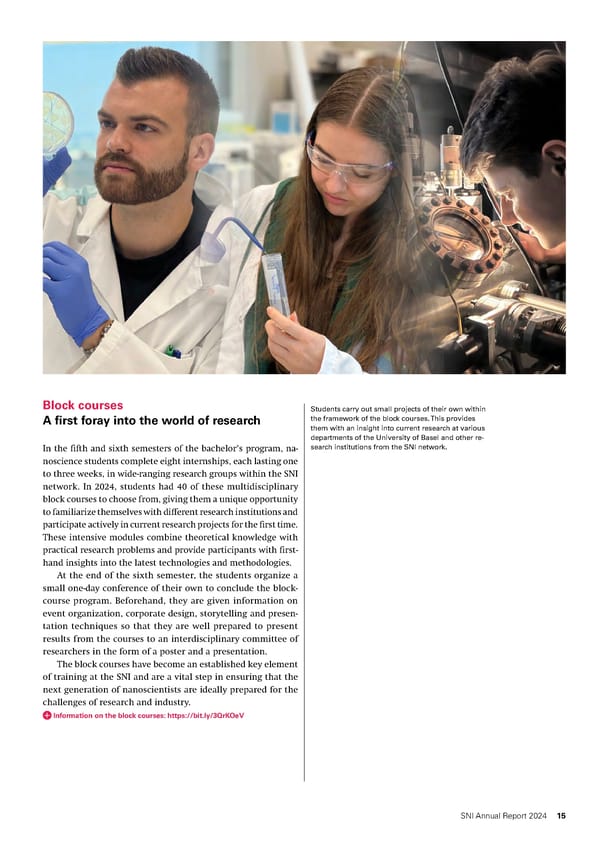
SNI PhD School Specialization with an insight into various fields A key part of the Swiss Nanoscience Institute’s mission is to train excel- lent young nanoscientists who are capable of working at the interfaces between various disciplines in order to tackle the challenges of the fu- ture. Founded in 2012, the SNI PhD School ensures that, every year, it turns out early career researchers who are not only specialists in their subject area but also have a broad understanding of topics outside their own discipline. This is achieved through a combination of the interdisciplinary events of the SNI network and courses developed specially for the SNI PhD School. In 2024, the revised “From Lab to Startup” workshop also featured in the program for the first time, giving doctoral students the chance to experience the first steps in founding a startup based on spe- cific concepts that they developed themselves. A total of 40 doctoral students were enrolled in the SNI PhD School in 2024, almost 25% of whom were women. Seven doctoral students successfully completed their doctoral dissertations in 2024. Six new dissertation projects were approved in 2024 and will begin in 2025. Of the 60 SNI doctoral students who have completed their dissertations so far, around 70% were employed in industry at the end of 2024. In addition, almost 30% of former SNI doctoral students are employed at research institutions or federal offices. 16 SNI Annual Report 2024
Melissa Carrillo worked on her doctoral thesis at Annika Huber completed her doctoral thesis at Maria-Elisenda Alaball Pujol conducted research the Paul Scherrer Institute and is now a postdoc- the Department of Chemistry at the University of for her doctoral thesis at the Biozentrum of the toral researcher at Northwestern University in Basel. University of Basel. Chicago IL (USA). Novel sample carrier for crystallo- Sensor for gas-phase molecules Microfluidics for antibiotics research graphic investigations In her doctoral dissertation, Dr. Annika As part of her doctoral dissertation, Dr. In her doctoral dissertation, Dr. Melissa Huber developed a nanomaterial that Maria-Elisenda Alaball Pujol has developed Carrillo developed and tested a new type can be used as a sensor for certain gas- an integrated microfluidic system that can of polymer sample carrier that is ideally phase molecules — specifically, asymme- be used to quantify how bacteria response suited for investigating protein crystals tric molecules that have the same che- to different antibiotics depending on their at synchrotron and X-ray free-electron la- mical formula but whose reflections are physiological state. The method allows the ser sources. non-superimposable. These “enantio- identification of antimicrobial compounds A transparent micro-structured poly- mers” have the same physical properties that can be used specifically to target re- mer membrane equipped with thousands but rotate polarized light in different di- sistant subpopulations and supplement of pyramid-shaped indentations with tiny rections (clockwise and counterclockwi- existing treatments. holes at their bottom serves as the sample se). Since their biological modes of ac- For her investigations, Maria-Elisenda carrier. During sample deposition, the tion can be very different, it is important has further developed and used an inte- protein crystals to be analyzed self-align to detect the two enantiomers separately grated microfluidic and computer-aided in these 100 x 100 µm2 cavities, allowing from one another — which is difÏcult gi- setup (dual-input Mother Machine). Here, their position to be determined prior to ven their similarity. the bacteria grow in narrow growth chan- analysis. The sample carrier is character- The nanomaterial developed by An- nels that run perpendicular to a main ized by minimal background signal, us- nika Huber consists of square-planar pla- channel. The bacteria can be supplied er-friendly handling, durability and high tinum complexes, which are known for with different media under adjustable reusability. It also offers the potential for their tendency to form stacked aggrega- conditions. The supply of various antibi- cost-effective mass production. tes with short metal–metal distances. otics can also be precisely controlled. The In her work, Melissa also produced an This can result in one-dimensional na- image analysis software Mother Machine opaque version of the carrier for experi- nostructures that exhibit high electrical Analyzer enables the monitoring of bac- ments with light-responsive proteins. Us- conductivity, vapochromism and photo- terial cells over time. Maria-Elisenda has ing these carriers she has analyzed ligand luminescence. By modifying the plati- developed new microfluidic circuits that binding of a light-driven system to un- num complexes, Annika induced asym- allow testing several antibiotics and bac- cover the structural dynamics of binding metric stacking that responded terial strains in parallel. With this new events. differently to the counterclockwise or technology, she was able to track single Publication: https://bit.ly/3WefdQX clockwise form of the molecule pairs un- bacteria before, during and after antibi- der analysis. Based on five tested pairs, otic administration and evaluate their she succeeded in showing that the plati- survival. For the investigations, she fo- num complexes can, in principle, be cused on the treatment of Escherichia used as an enantiospecific sensor. This coli with a number of clinically relevant could, for example, allow her to detect antibiotics. specific climate-relevant terpenes from the atmosphere. Video: https://youtu.be/8JxTRe8rRPo SNI Annual Report 2024 17
Gian-Luca Schmid completed his doctoral thesis Moritz Weegen completed his experimental work Josh Zuber completed his doctorate at the Depart- at the Department of Physics at the University of at the Departments of Chemistry and Physics of ment of Physics of the University of Basel, where Basel and continued his work there as a postdoc- the University of Basel. He is currently working he continued working as a postdoc. toral researcher. as a data engineer at IWB. Coupled with light Coupling a solid body to an atomic Sensitive sensors based on diamond In his doctoral dissertation, Dr. Gian-Luca system color centers Schmid used laser light to couple two dif- For his doctoral dissertation, Moritz Wee- For his doctoral dissertation, Dr. Josh Zu- ferent quantum systems over a relatively gen developed and then characterized a ber studied silicon vacancy centers in di- large distance of one meter. Interfaces of hybrid system consisting of a solid body amonds with a view to potential applica- this kind are vital for future quantum and a small number of atoms. tions in scanning probe magnetometry. technologies. He achieved this by coupling a charged These diamond color centers are particu- For the microscopic system, Gian-Luca nanomechanical oscillator in the form of larly interesting because they exhibit ex- Schmid used the collective spin of a cloud a silver-gallium nanowire (Ag2Ga) to indi- cellent optical and spin properties even + of cold rubidium atoms, while the mac- vidual calcium ions (Ca ) caught in a under extreme conditions, as well as pos- roscopic system was a vibrating mem- high-frequency trap. This creates a hybrid sessing outstanding photostability. brane positioned between two mirrors. system in which the calcium ions can be Josh Zuber’s work showed that, The membrane had a nanostructure that excited by mechanical motion of the thanks to their high spatial resolution optimized the vibrational properties. nanowire. In his experimental work, and sensitivity, negatively charged silicon Gian-Luca used the interaction be- Moritz Weegen showed that the strength vacancy centers in optimized nanostruc- tween the two systems to cool the me- of coupling depends on various parame- tures (SiV–) were suitable for studying chanical oscillator down to a temperature ters, such as the mechanical properties complex physical systems whose analysis close to absolute zero within a fraction and oscillation amplitude of the nanowire, is only possible in extremely low tem- of a second. This process involves first the distance between the nanowire and peratures (
Fabian Züger carried out his experimental work at the FHNW School of Life Sciences. Replacement tissue for the heart In his doctoral dissertation, Dr. Fabian Züger developed a promising strategy to produce replacement heart tissue that mimics the structures and characteristics of the cardiac muscle. As a base material, he developed a tai- lor-made bioink made of methyl cellulose Morris Degen (left) won the prize for the best talk and gelatin that contained myocardial and Anamarija Nikoletić (right) the prize for the cells from rats and showed excellent best poster at the Annual Event in 2024 at Lake printing properties. The ink could be used Hallwil. SNI Director Martino Poggio (center) pre- sented the prizes at the end of the two-day con- to print up to 5.4 million cells per milli- ference. (Image: K. Beyer-Hans, SNI, University of meter and to configure the stiffness in Basel) order to mimic the various tissue types, including the cardiac muscle. Fabian Züger also used electrospinning to pro- duce fine, conductive, tailor-made nano- fibers comprising a mixture of carbon “The SNI Annual Event is nanotubes and polycaprolactone, deliver- always a special highlight for ing a combination that mimicked the nat- me, as it offers a unique oppor- ural extracellular matrix of the heart. tunity to gain insights into In Fabians’s investigations, over 90% cutting-edge research outside of the printed cardiac muscle cells sur- my own field and to exchange vived. After just five to eight days, the ideas with researchers from a cells began to contract spontaneously — wide range of disciplines in a which is normal and desirable behavior relaxed atmosphere. It was a for heart cells. The conductive nanofibers great honor to receive the Best had a positive influence on the control of Talk Award for my presentation.” such cells. Morris Degen, This system successfully combines the Doctoral student at the SNI PhD benefits of 3D bioprinting and electro- School and winner of the Best Talk spinning, offering an innovative method Award at the Annual Event 2024 for the production of cardiac tissue for research and potential applications in re- generative medicine. Publication: https://doi.org/10.3390/biomi- metics8010027 SNI Annual Report 2024 19
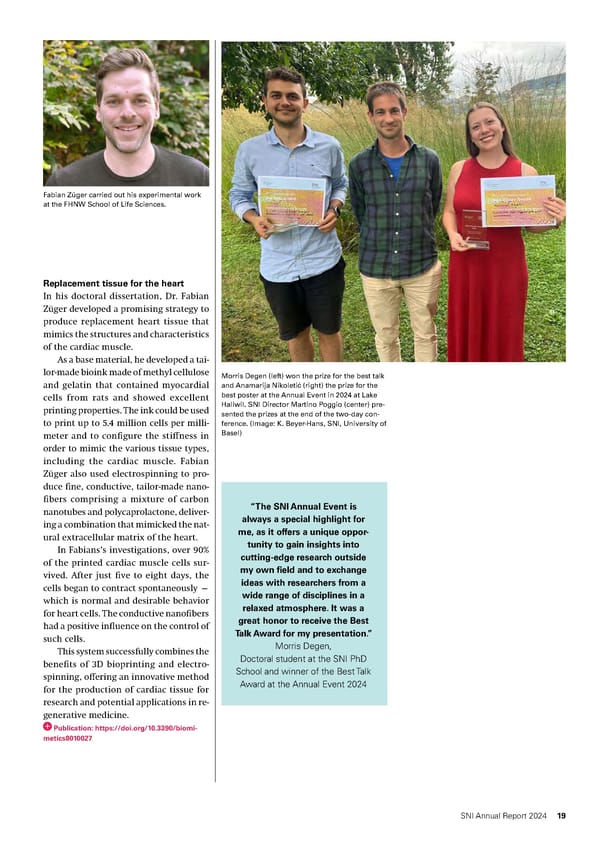
In 2024, seven SNI doctoral students successfully complet- ed their dissertations, having carried out the corresponding experi- mental work at the Biozentrum, at the Departments of Chem- istry and Physics of the University of Basel, at the FHNW School of Life Scienc- es, or at the Paul Scherrer Institute. SNI doctoral students noscience in the Snow” Winter School. In 2024, this Interdisciplinary networking event featured extended talks by the invited experts on nanomagnetism, surface chemistry, molecular Successfully defending their doctoral dissertation is biological methods, and the advantages of a doctor- the crowning glory for all doctoral students. By this ate on the startup scene. Likewise, broad-based train- point, they have been fully integrated into research ing for doctoral students is supported by initiatives groups at various departments of the University of such as the startup workshop that was recently in- Basel (Biozentrum, Chemistry, Physics), the Paul corporated into the program or the course on com- Scherrer Institute PSI and the University of Applied munication or rhetoric. SNI events that are held on Sciences Northwestern Switzerland (FHNW), as well a yearly basis, such as the Annual Event and the as having overcome numerous hurdles during their NanoTec Apéro, also play a key role in ensuring that dissertations and proving that they can deal with the young early career researchers are ideally complex challenges independently. Over the past equipped to continue their professional careers at few years, they have gained a wealth of technical the interfaces between different disciplines. knowledge in their specialist field and successfully presented their results to relevant expert audiences through talks and publications. At the same time, doctoral students at the SNI “I found the SNI PhD School to be an ex- PhD School have not only built up a network within tremely valuable experience, involving a their field of research, but have also become part of lively exchange of ideas and interdisciplin- the interdisciplinary SNI network. They have grap- ary opportunities not only for further devel- pled with subjects well beyond their field, immersed opment but also to look beyond one’s own themselves in other research topics, and discussed horizons and for networking.” ideas with researchers from other disciplines. They Annika Huber, have also learned to explain their research to a dis- former doctoral student at the SNI PhD School cerning non-specialist audience through numerous events organized by the SNI team, such as the “Na- 20 SNI Annual Report 2024
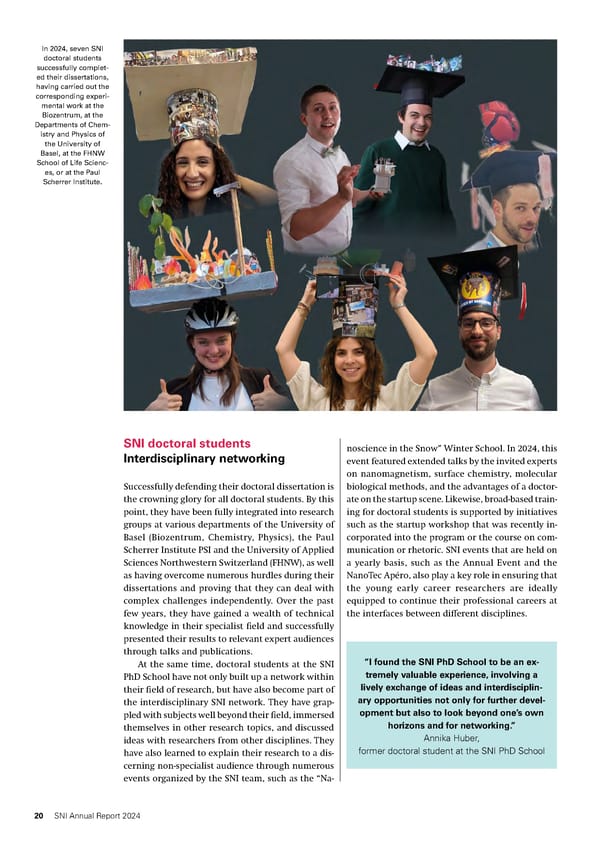
SNI startup workshop “From Lab to Startup” Doctoral students from the SNI PhD gether with Mauricio Campos, the owner School generally work on questions of ba- of a consulting firm. As well as theoretical sic research, but these topics are often knowledge, Pekonen provided partici- only a short step away from innovative pants with practical experience. Two suc- applications. In mid-October, seven SNI cessful company founders shared their doctoral students gained insights into the insights, and the students developed their world of founding a startup at the “From own concepts for startups — generally Lab to Startup” workshop. Under the guid- based on their own research. Elizaveta At the workshop, Elizaveta Maksimo- ance of experts, they developed business Maksimova, from the team led by Profes- va impressed the jury with her clear ideas, learned about the key steps in sor Jonathan de Roo (Department of presentation and won the prize for the best pitch. founding a company, and presented their Chemistry), gave the best pitch and won ideas as part of a pitching competition. the jury over with her clear presentation. The coordinator of the SNI PhD School, Through this program, the SNI seeks Dr. Andreas Baumgartner, worked with to encourage SNI doctoral students to ex- “I further developed the academic Anna-Elina Pekonen from the Innovation plore alternative career pathways and ex- ideas from my dissertation project OfÏce of the University of Basel to develop amine practical applications of their re- and felt very comfortable thinking a new concept for the “From Lab to search. The workshop was a complete about the next step to founding a Startup” workshop, which is to be held success and will continue to support startup. The SNI Rhetoric Workshop on an annual basis going forward. In young researchers on their journeys in I attended last year really helped mid-October, Pekonen then hosted the the future. me deliver a convincing first installment of this workshop to- Report in SNI INSight: https://bit.ly/40OrE7r presentation.” Elizaveta Maksimova, SNI doctoral student at the Department of Chemistry of the Uni- versity of Basel and winner of the pitching competition “It was great to see how the participants developed their projects in a very short time period of just 1.5 days, resulting in an impressive outcome.” Anna-Elina Pekonen, Innovation Office, University of Basel The concept of the “From Lab to Startup” work- shop impressed both the participants and the course leaders. From now on, the workshop will be offered to a group of SNI doctoral students ev- ery year so that all members of the SNI PhD School experience these valuable insights into setting up a company once during their doctor- ate. (Image: A. Baumgartner, SNI, University of Basel) SNI Annual Report 2024 21
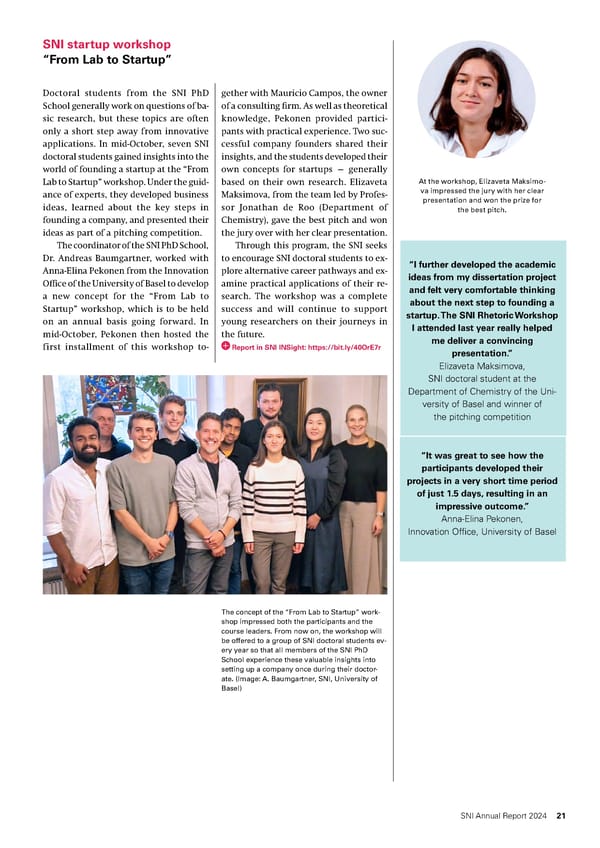
250 200 150 100 50 22SNI Annual Report 2024 0
250 Oscillation of a nanodrum Tiny membranes are structured by arrangements of nanopillars so that they adopt vibrational modes with tailored properties. The nanopillars are missing in the 200 center of the membrane, meaning that the central area can vibrate with extremely low dissipation. This figure shows a measurement of the membrane’s vibration amplitude, which is very large in the center and becomes smaller toward the edges. The researchers use nanodrums such as these for quantum science, and the image was among the winners of the 2024 Nano Image Award. (Image: Gian-Luca Schmid, Department of Physics, University of Basel) More information on basic research from 150 page 24 onward. 100 50 SNI Annual Report 2024 23 0
Research: Founded on basic science A large part of research activities supported by the Swiss Nano- science Institute focus on questions of basic science. After all, it is only by understanding how nanoscale systems work that we can develop applications based on this knowledge. Researchers in the SNI network benefit from access to wide-rang- ing experts from the various partner institutions and departments. Accordingly, the research projects supported by the SNI are also highly diverse, ranging from questions about our understanding of fundamental quantum physical phenomena to approaches rooted in materials science and biomedical applications. At the same time, researchers in the SNI network focus primarily on making the nanoworld “visible” and on producing nanoscale structures and ma- terials that can then be applied in fields including quantum, materi- als or environmental science as well as in the life sciences and medicine. - In 2024, scientists from the SNI network published 74 articles in re nowned scientific journals. Here, we bring you a small selection of these publications in order to reflect the diversity of subject areas and findings obtained. Through this research work, SNI members help to gain a better understanding of processes and laws govern - ing the world of tiny structures, thereby paving the way for potential applications . 24 SNI Annual Report 2024
Contents of individual cells Fine-tuned interaction is key Researchers from the SNI network have described a new method A research team from the University of Basel has investigated for analyzing metabolic products and proteins from individual specific proteins (exportins) that are involved in the transport or small numbers of cells. The scientists use a short electropo- of molecules from the cell nucleus to the cytoplasm. The study ration procedure to break open individual cells and aspirate the showed that certain areas of exportin-2 (also known as CAS) and cell contents using a fine capillary under an optical microscope. other proteins ensure that CAS remains in the cell nucleus un- They then analyze the samples using liquid chromatogra- til it is needed. A mutation or an imbalance in this process can phy-mass spectrometry (LC-MS) and other methods. This tech- lead to pathological cell behavior, as is the case with cancer. nique allows precise measurements of cell structures, metabolic These findings demonstrate the importance of the balanced products and proteins at single-cell level and opens up new interaction of proteins for transport into and out of the cell possibilities for biomedical research. nucleus. Original publication: https://doi.org/10.1039/D4LC00269E Original publication: https://rupress.org/jcb/article/223/2/ e202306094/276511/Mechanism-of-exportin-retention-in-the-cell The top row shows a target cell (black arrow) before electroporation and as- piration of the cell contents. In the images in the bottom row, the cell con- tents have been aspirated. The fluorescent signal originates from labeled, pathogenic amyloids that were absorbed by the cell. The white bar corre- sponds to a length of 100 μm. (Image: A. Fränkl, L. Rima, Biozentrum, Uni- versity of Basel) Using a fluorescence microscope, the researchers observe the importance of finely tuned interaction between the exportins and RanGTP. A single mu- tation changes the fate of CAS in the cell nucleus, as illustrated by the differ- ence between the wild-type and a mutated form. (Image: L. Kapinos, Bio- zentrum, University of Basel) SNI Annual Report 2024 25
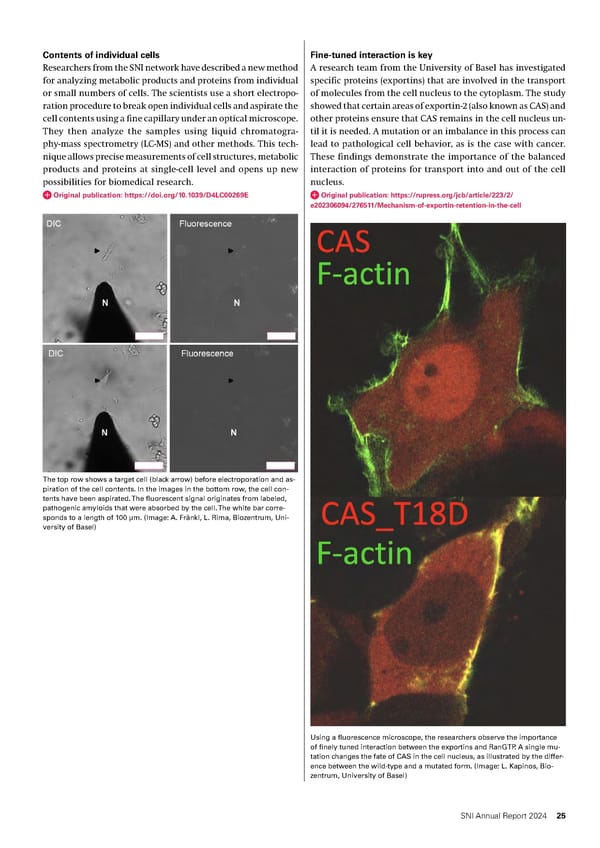
Method for detecting nanoparticles in early life nutrition Colorized transmission electron microscope In the Nano-Argovia program, researchers from the SNI network (TEM) image of silicon dioxide nanoparticles have developed a technique that can detect nanoparticles (that (SiNPs, green) in a matrix (orange). Scale bar = 400 nm (Image: FHNW) is, particles with a diameter of less than 100 nanometers) in early life nutrition products with a high sample throughput. Original publication: https://doi.org/10.1021/acsomega.3c09459 26 SNI Annual Report 2024
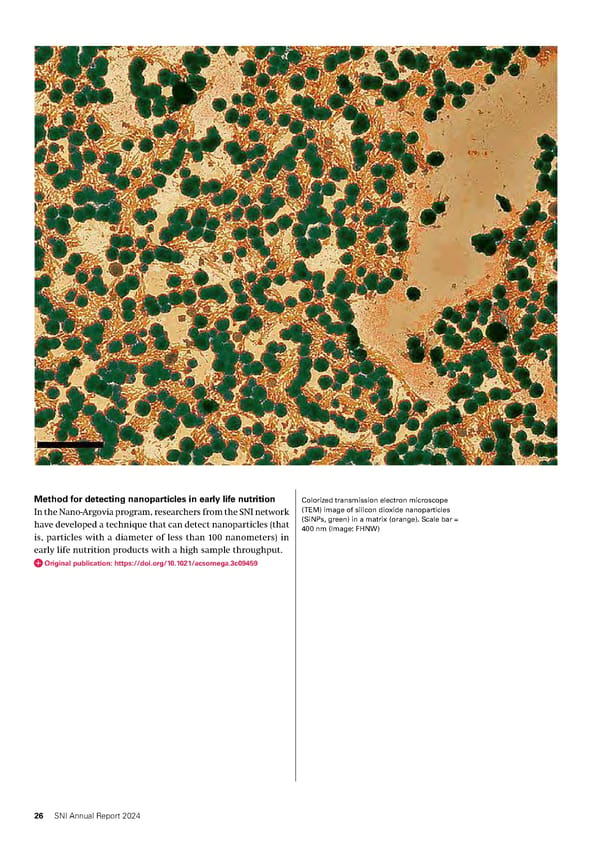
Nanocompartments for enzymatic reactions Nanostructures for better implants Scientists from our network have developed novel nanoclusters Researchers from the SNI network have investigated how nano- inspired by the manner in which natural cells interact inside structured titanium surfaces (Ti2 spikes) can improve dental tissues. These smart clusters — which consist of catalytic nano- implants. The interdisciplinary team investigated the viability compartments (CNCs) loaded with enzymes precisely attached of osteoblasts and fibroblasts and controlled how different bac- to Janus nanoparticles (JNPs) — are specifically assembled by terial strains colonized the modified surfaces. programmed DNA hybridization. The unique asymmetry of the Original publication: https://onlinelibrary.wiley.com/doi/10.1002/jbm.a.37768 JNPs orients the arrangement of CNCs on specific lobes of Janus Video: https://youtu.be/9yRkvlNvL2w nanoparticles, while the clusters provide a confined space for different types of enzymatic reactions and induce their direc- tionality. This new technology offers a powerful tool for design- ing smart materials with precise temporal and spatial control of the nanoscale reactions that are required in various fields, including in medicine and biotechnology. Original publication: https://www.sciencedirect.com/science/article/pii/ S1369702124001858?via%3Dihub Nanostructured titanium surfaces can influence the growth of bacteria and impact the viability of osteoblasts and fibroblasts. (Image: Department of Physics, University of Basel) Synthetic cells emulate natural cellular communication A team of researchers from the University of Basel has suc- ceeded in synthesizing simple, environmentally sensitive cells Electron microscope image of nanoclusters whose structure is modeled on complete with artificial organelles. For the first time, the re- natural cells in tissues. (Image: Department of Chemistry, University of Basel) searchers were also able to emulate natural cell-cell communi- cation using these protocells — based on the model of photo- receptors in the eye. This opens up new possibilities for basic research and applications in medicine. Original publication: https://doi.org/10.1002/adma.202413981 Schematic representation of synthetic cell communication. (Illustration: Oliv- ia Fischer, University of Basel) SNI Annual Report 2024 27
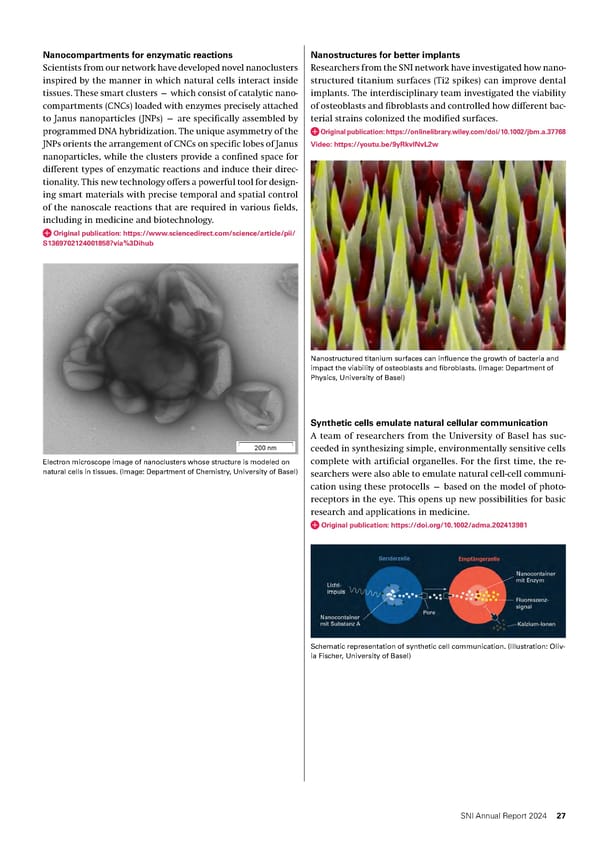
Protecting enzymes Hybrid transport system for genetic material Researchers from the SNI network have investigated methods Lipid nanoparticles are an important means of transport for for stabilizing enzymes by tailoring their nanoenvironment and genetic material (nucleic acids) and came to attention partly without impairing their structure or function. To this end, they due to COVID-19 vaccines. Their efÏciency is limited, however, used ring-shaped sugar molecules (cyclodextrins) that stabilized as only a small proportion of the transported nucleic acids en- the three-dimensional structure of the proteins due to supra- ters the cells. To improve the level of uptake, researchers from molecular interactions with their surface. The protective effect the SNI network combined lipid nanoparticles with vesicles can be further enhanced if the cyclodextrins are integrated into derived from natural cells. The resulting hybrids showed a sig- an organosilica layer. Enzymes immobilized in this way showed nificantly increased rate of gene expression in vitro and in vivo. improved heat stability and recovery after damage by various The inclusion of cell-derived vesicles could potentially stream- stress factors. line the development process and significantly improve the ef- Original publication: https://doi.org/10.1002/cbic.202400840 ficacy and potency of gene delivery systems without the need for extensive screening. Original publication: https://doi.org/10.1002/adhm.202401888 Enzymes can be immobilized and protected with the help of the nanoenvi- ronment. (Image: FHNW) Width of artificial pores is crucial Researchers within the SNI network have shown that the width of nuclear pore complexes is critical in transport into and out Researchers use fluorescence microscopy to check the expression of genes of the cell nucleus and that nuclear transport receptors play an that were introduced into cells using the hybrid transport system. (Image: C. active role in transport regulation. Alter, Department of Pharmaceutical Sciences, University of Basel) Nucleoporins in nuclear pore complexes form a selective barrier that suppresses the diffusion of most large molecules while enabling the rapid transport of molecules bound to nu- clear transport receptors. Now, the researchers have constructed artificial pores from DNA with different diameters and nucleo- porin arrangements. Using virus particles, the researchers found that certain nucleoporins formed an impermeable barrier for the virus particles in narrow pores (60 nm), while they were less effective in larger pores (79 nm). Original publication: https://www.science.org/doi/10.1126/sciadv. adq8773 28 SNI Annual Report 2024
The tumor microenvironment is often associated Nanoparticles for more effective immunotherapy with a very low pH value. Researchers from the Researchers from the SNI network have explored an innovative SNI network are investigating how nanoparticles approach with a view to improving the effectiveness of existing can be used to neutralize intracellular acidity of tumor and immune-suppressing cells. Initial cancer treatments such as immunotherapies. To this end, they studies indicate that reducing the acidity can developed nanoparticles carrying a drug known as esomepra- have a positive effect on the body’s immune re- zole (commonly used to treat gastric acidity) in order to target sponse to the tumor. (Image: FHNW, generated with Canva) and reduce tumor acidity. When tested on skin cancer cells, these nanoparticles not only reduced the acidic environment of tumor cells, but also altered their behavior. This included a reduction in factors that help tumors evade the immune system. Moreover, the treatment modified immunosuppressive cells from patients in a way that boosted their ability to support the body’s natural immune response against cancer. Original publication: https://doi.org/10.1016/j.isci.2024.111559 SNI Annual Report 2024 29
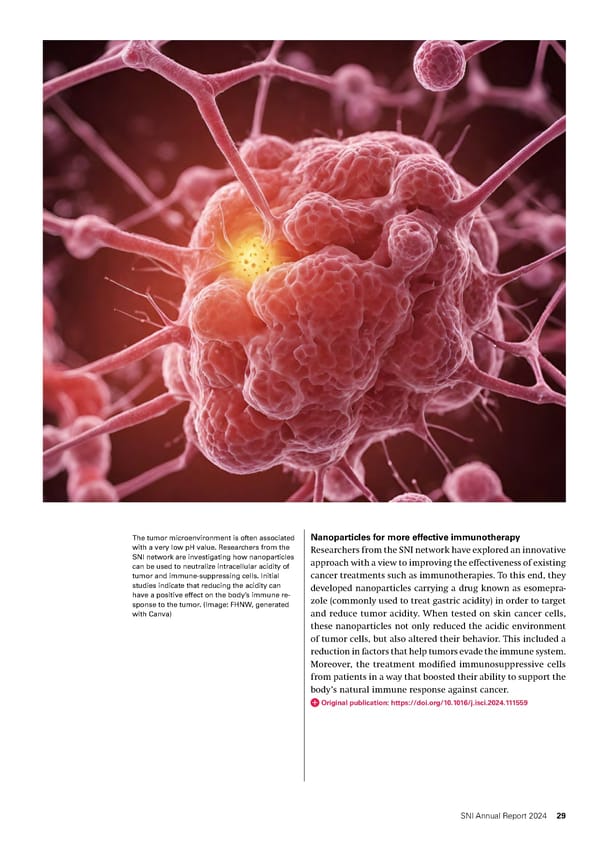
Reversal of magnetism through stretching Strong coupling between Andreev qubits mediated Ribbons of the two-dimensional semiconductor chromium sul- by a microwave resonator fide bromide (CrSBr) change their magnetization when they are Physicists from the University of Basel have succeeded in cou- stretched. Researchers from the SNI network have published pling two Andreev qubits coherently over a macroscopic dis- details of how they selectively stretch thin chromium sulfide tance for the first time. They achieved this using microwave bromide ribbons consisting of a few atomic layers and observe photons generated in a narrow superconducting resonator. The them using a cantilever probe with an integrated superconduct- results of the experiments and accompanying calculations were ing quantum interference device (SQUID). The researchers were recently published, laying the foundation for the use of coupled able to prove that the layered, two-dimensional CrSBr loses its Andreev qubits in quantum communication and quantum com- antiferromagnetic properties due to stretching and becomes a puting. ferromagnet. They reproduced this change in magnetization, Original publication: https://www.nature.com/articles/s41567-024- as well as the formation of domains, using a micromagnetic 02630-w model. Original publication: https://doi.org/10.1021/acs.nanolett.4c03919 Magnetic field dependence of a strained chromium sulfur bromide ribbon. Andreev qubit coupler: The long microwave resonator (a) couples two An- (Department of Physics, University of Basel) dreev qubits (left (b), right (c)). The port in the center of image (a) is the read- out port. The magnification of a single nanowire (d) gives an idea of the tiny size of a single qubit, and the nanowire is coated with a superconductor (cyan). The actual Andreev bound state, which forms the qubit states, is lo- cated in the central white section marked by the red arrow. There is also a Coupling between a nanowire and ions similar nanowire on the left quantum device. (Image: C. Schönenberger, De- As part of a doctoral thesis at the SNI PhD School, researchers partment of Physics, University of Basel) have combined an ultra-thin metal wire (nanowire) with coolable ions in a special trap. They were able to set the ions in motion in a targeted manner by mechanically vibrating the nanowire — both resonantly (in harmony with the natural movement of the ions) and non-resonantly. The results show that it is possible to achieve mechanical coupling between ions and a nano-oscillator. In the future, this could open up new avenues for mechanically controlling the motion of trapped ions or for the development of hybrid quantum systems. Original publication: https://doi.org/10.1103/PhysRevLett.133.223201 In a special trap (represented by the yellow structures), ions can be set in motion by mechanical vibrations of a nanowire (at the gray tip). (Image: De- partment of Chemistry, University of Basel) 30 SNI Annual Report 2024
Friction depends on speed 2D layer of phosphorus pentamers shows semiconductor Researchers from the University of Basel have demonstrated properties on silver surface that on the nanometer scale, frictional forces depend on speed. Researchers at the University of Basel have synthesized The researchers moved the tip of an atomic force microscope five-membered rings of phosphorus atoms (phosphorus pen- (AFM) over a monolayer of molybdenum disulfide on a gold tamers (cyclo-P5)) on a silver surface and investigated their elec- surface and found that the friction between the AFM tip and tronic properties for the first time using combined atomic force the surface decreases over a broad speed range from 10 to 100 and scanning tunneling spectroscopy. The researchers found nanometers per second. These results deviate from the classical that the atomic phosphorus pentamer layer retains its semicon- Coulomb’s law of friction, which describes the independence ductor properties and that a special electronic interface forms of friction from velocity. at the boundary with the silver surface (p-type semiconduc- Original publication: https://doi.org/10.1103/PhysRevLett.133.136201 tor-metal Schottky junction). The phosphorus pentamers on the silver surface therefore fulfill a basic requirement for applica- tions in field-effect transistors, diodes or solar cells. Original publication: https://www.nature.com/articles/s41467-024-50862-4 SNI post: https://bit.ly/4jAWwRt Researchers use an AFM to investigate friction on the nanometer scale over a monolayer of molybdenum disulfide on a gold surface. (Image: Depart- ment of Physics, University of Basel) When two-dimensional layers containing rings of five phosphorus atoms Novel femtosecond laser (phosphorus pentamers) are formed by self-assembly on a silver surface, the phosphorus layer retains its semiconductor properties, and a special in- Researchers from the SNI network have developed ultrashort terface (a p-type semiconductor-metal Schottky junction) forms at the alexandrite lasers that are pumped with recently developed red boundary with the silver surface. (Image: R. Pawlak, Department of Physics, laser diodes at 638 nm. These lasers are suitable for various University of Basel) high-tech applications. As well as providing high peak power, the combination of direct diode pumps and the extremely short light pulses (44 and 95 femtoseconds) makes the lasers partic- ularly efÏcient and versatile for modern applications in science and technology. Original publication: https://doi.org/10.1364/OE.542834 The researchers used the newly developed femtosecond laser to develop optical tweezers as part of the Nano-Argovia project NanoFemto Tweezers. SNI Annual Report 2024 31
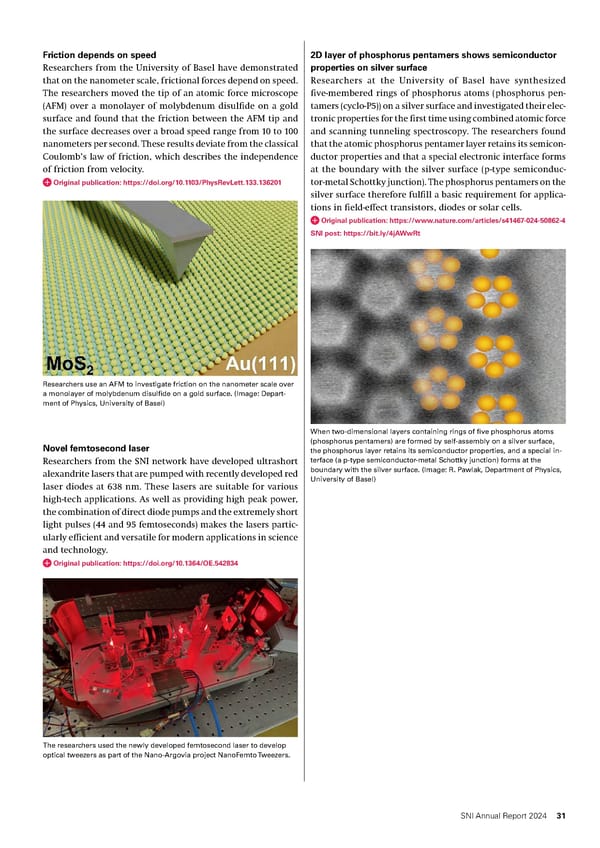
Strong spin-photon coupling Using a complex experimental setup, researchers Researchers from the SNI network have achieved strong cou- from the SNI network achieved strong coupling pling between an electron spin and a single photon. Normally, between an electron spin and a photon. (Image: A. Pally, Department of Physics, University of Ba- there is only very weak coupling between a single photon and sel) an electron spin. To achieve strong coupling, the researchers therefore used a special indium arsenide crystal structure, which couples the electron spin naturally to its motional degree of freedom, thereby making it open to interaction with a mi- crowave photon. Original publication: https://www.nature.com/articles/s41467-024- 45235-w SNI post: https://bit.ly/40Q2fdG 32 SNI Annual Report 2024
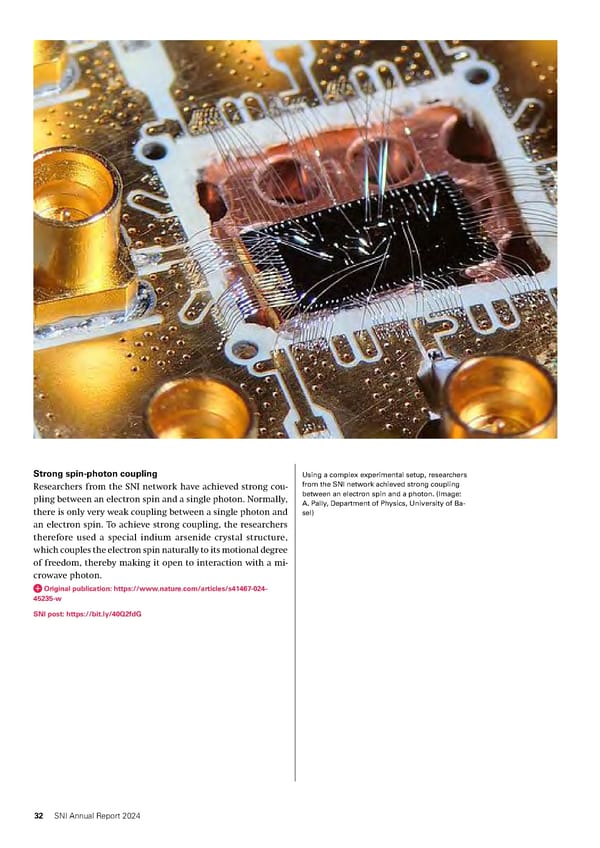
Mass-producible miniature quantum memory Voltage-tuned superconducting qubits Researchers at the University of Basel have built a quantum Researchers from the SNI network have developed a new qubit memory element based on atoms in a tiny glass cell. In the platform that may be suitable for various applications. In con- future, quantum memories of this kind could be mass-produced trast to conventional superconducting qubits made of metals, on a wafer. the team combined a technologically relevant semiconductor Original publication: https://doi.org/10.1103/PhysRevLett.131.260801 with superconducting elements to create a “gatemon” qubit News report from the University of Basel: https://bit.ly/3CZwpmQ with promising properties. Original publication: https://doi.org/10.1021/acs.nanolett.4c00770 SNI post: https://bit.ly/4k4jocq Light pulses can be stored in and retrieved from the glass cell, which is filled with rubidium atoms and is only a few millimeters in size. (Image: University of Basel, Department of Physics/Scixel) The researchers from Basel fabricated a high-quality Josephson junction on a germanium/silicon nanowire between two superconductors (black and New method for determining the exchange energy white image, top right), thereby producing the central part of a “gatemon” qubit. (Image: H. Zheng, Department of Physics, University of Basel). of 2D materials Researchers from the University of Basel have looked at how the ferromagnetic properties of electrons in the two-dimen- sional semiconductor molybdenum disulfide can be better un- Control of skyrmions possible derstood. They revealed a surprisingly simple way of measuring Using scanning SQUID microscopy at very low temperatures, the energy needed to flip an electron spin. researchers from the SNI network have visualized the micro- Original publication: https://doi.org/10.1103/PhysRevLett.133.026501 scopic structure of magnetic phases and their transitions on the SNI post: https://bit.ly/3EJ4Kad surface of the insulator Cu OSeO . The researchers observed that 2 3 under certain conditions, the surface is populated by clusters of disordered magnetic vortex structures (skyrmions), and that individual skyrmions could be controlled locally. Original publication: https://www.nature.com/articles/s43246-024-00647-5 SNI post: https://bit.ly/41oONyY The two-dimensional semiconductor material molybdenum disulfide is filled with electrons (red spheres). Electron-electron interactions cause the spins of all electrons (red arrows) to align in the same direction. The ex- change energy needed to flip a single electron spin in the ferromagnetic state can be determined from the separation between two specific spectral lines. (Image: N. Leisgang, Harvard University, formerly Department of Physics, University of Basel/Scixel) The microscopic structure of the magnetic phases and transitions of the in- sulator Cu OSeO . (Image: Department of Physics, University of Basel) 2 3 SNI Annual Report 2024 33
34 SNI Annual Report 2024
Cooperation as the key to innovation The SNI’s Nano-Argovia program is a guarantee for effective knowledge and technology transfer between research institu- tions and industrial companies from Northwestern Switzerland. Each year, the SNI supports around ten applied research projects in which interdisciplinary teams work to solve a wide range of challenges. More on this from page 36 Lasers have already played a role in several Nano-Argovia projects. In the NanoFemto Tweezers project, novel lasers are used in combination with nano-optical elements as optical tweezers. The researchers want to use them to precisely assemble different cell types into a complex organ system on a microscopic surface. More on page 43 SNI Annual Report 2024 35
Nano-Argovia program: Productive collaboration with companies from Northwestern Switzerland Ever since the SNI was founded, a priority has been the promotion of knowledge and technology transfer with a view to driving progress and innovation at companies. The SNI supports this transfer through its Nano-Argovia program, which has existed since the institute’s es - tablishment. As part of this successful initiative, the SNI has so far funded around 100 projects in collaboration with almost 70 companies from Northwestern Switzerland, helping them take the first steps to - ward numerous nanotechnological applications. In 2024, the Nano-Argovia program funded a total of 10 projects. Five - of these began in 2024, while five project teams had begun their re search back in 2023. In six of the projects, the partner companies hailed from the Canton of Aargau, while the partners in the other four hailed from one of the Basel half-cantons. In terms of the academic partners, the participants were primarily staff of the Paul Scherrer In - stitute PSI and the University of Applied Sciences Northwestern Swit- zerland (FHNW) in Muttenz and Windisch – although researchers from the University of Basel and CSEM Allschwil also acted as project part - ners, using their expertise to drive advances in these interdisciplinary topics of research. Nano-Argovia program: www.nano-argovia.swiss 36 SNI Annual Report 2024
In a protected atmosphere, doctoral student Rob- Better and safer lithium batteries in Wullich assembles prototypes of the “reser- In the Nano-Argovia project BatCoat, researchers began devel- voir-free” lithium metal solid-state battery cells in order to subsequently investigate their electro- oping the next generation of zero-excess all-solid-state lithi- chemical properties. um-metal battery cells in early 2024. These solid-state Li-metal batteries represent a promising alternative to conventional lith- ium-ion battery cells. They have a higher energy density and are safer than the lithium-ion batteries used today. Accordingly, they could make a decisive contribution to effective, safe and “The project potentially allows sustainable electromobility. At present, however, there are still us to enter the value chain of some technical challenges, which are being investigated by the Gen 3 and Gen 4 lithium-metal interdisciplinary team in the Nano-Argovia project BatCoat. cell technology with a strong The negatively charged electrode (anode) of the zero-excess unique selling proposition.” all-solid-state lithium-metal battery cells being investigated con- Dr. Phani Kumar Yalamanchili, sists of a three-dimensional copper current collector, on which Oerlikon Metco AG the researchers deposit functional layers. These layers help to ensure that the lithium emitted by the cathode is deposited reversibly and evenly. In the first year of the project, the inter- disciplinary team successfully tested how these nanoscale func- tional layers can be deposited on the anode and what properties they have. The researchers have already achieved very promis- ing cycling performance of 200 charge and discharge cycles with 2 a capacity retention of 80% at a current density of 0.5 mA/cm . In the second year, the objective is to double or triple that per- formance in order to make it attractive for the battery industry. Collaboration between: Paul Scherrer Institute PSI // FHNW School of Engineering and Environment // Oerlikon Metco AG (Wohlen, AG) Project description: https://bit.ly/3CM6sqR SNI Annual Report 2024 37
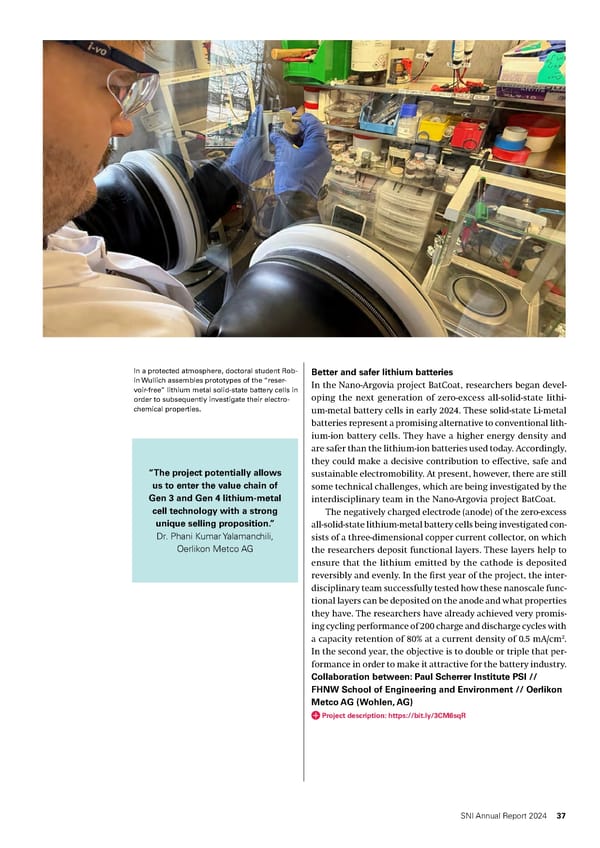
Detector for better electron microscope images The team in the Nano-Argovia project HiZfEM In the Nano-Argovia project HiZfEM, researchers have begun produced the electronic components required to developing a new hybrid pixel detector with improved image put the new hybrid pixel detector into operation. The researchers expect the new detector material quality for transmission electron microscopy. Like conventional (chromium-doped gallium arsenide) to generate models, the new electron detector is made up of two separate electron microscopic images with significantly layers, in which the sensor part is separated from the readout better resolution. chip. At present, comparatively thick silicon sensors are used as the detector layer in order to protect the sophisticated read- out electronics from the incident high-energy electrons — but these thick silicon sensors limit the imaging quality due to “We’re thrilled to collaborate on multiple scattering in the sensor. the HiZfEM project, where our In the Nano-Argovia project HiZfEM, however, the interdis- advanced GaAs material will ciplinary team has now used chromium-doped gallium arsenide play a crucial role in pushing (GaAs) as the detector material. In the project’s first year, the the boundaries of electron mi- researchers produced several components and characterized croscopy. This collaboration them using photons. They have pushed forward with data anal- with esteemed institutions like ysis and have already shown that it is possible to achieve a the Paul Scherrer Institute and significant improvement in image resolution. Initial tests on an the University of Basel under- electron microscope have delivered some very promising re- scores our commitment to pio- sults. neering scientific advancement Collaboration between: Paul Scherrer Institute PSI // Bio- and solidifies our position at zentrum, University of Basel // DECTRIS AG (Baden, AG) the forefront of hybrid pixel de- Project description: https://bit.ly/4hRwNCK tector technology.” Dr. Sonia Fernandez, DECTRIS AG 38 SNI Annual Report 2024
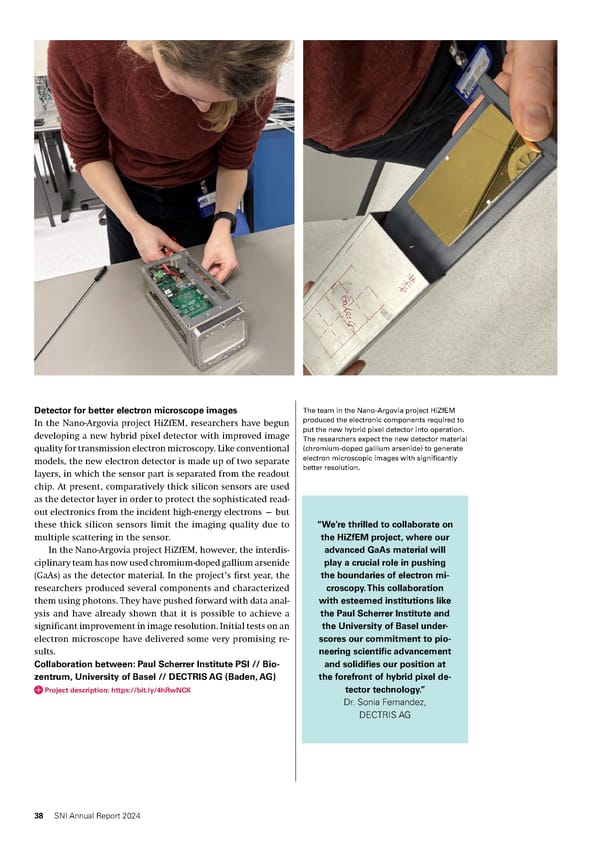
1 µm Scanning electron microscope image of a PET Enzymes to combat plastic waste film that is degraded by enzyme-based nanocat- In the Nano-Argovia project NANOdePET, researchers are work- alysts developed at the FHNW as part of the ing on an improved degradation method for polyethylene tere- NANOdePET project. (Image: FHNW) phthalate (PET). With global production of over 55 million tons per year, PET is one of the most common plastics and therefore a major component of plastic waste. Recycling methods for PET “This collaboration with FHNW, already exist today, but the quality deteriorates with each re- financially supported by the cycling process. SNI, offers INOFEA an opportu- In their approach, the researchers in the NANOdePET proj- nity to expand its portfolio of ect use enzymes (ester hydrolases) that break down PET. Using nano-engineered enzymes and nanotechnological methods, they immobilize the enzymes on to address environmental con- a silicon dioxide core and stabilize them with the help of so- cerns by providing a sustain- called artificial chaperones. In this way, the researchers achieve able solution to plastic waste. better stability and higher conversion rates than with dissolved INOFEA expects to gain a com- enzymes. In their application, a hybrid organic-inorganic coat- petitive edge and meet market ing of controlled thickness protects the enzymes used from demand for environmentally external influences but allows the enzymatic cleavage of PET. friendly products.” In the first year of the project, the interdisciplinary team Dr. Rita Correro, selected various ester hydrolases and tested their PET degrada- INOFEA AG tion activity using different PET materials. The researchers have optimized the conditions for efÏcient degradation and will now compare the method they have developed with current recy- cling methods and investigate the method’s suitability on an industrial scale. Collaboration between: FHNW School of Life Sciences // FHNW School of Engineering and Environment // INOFEA AG (Muttenz, BL) Project description: https://bit.ly/4gGXB7E SNI Annual Report 2024 39
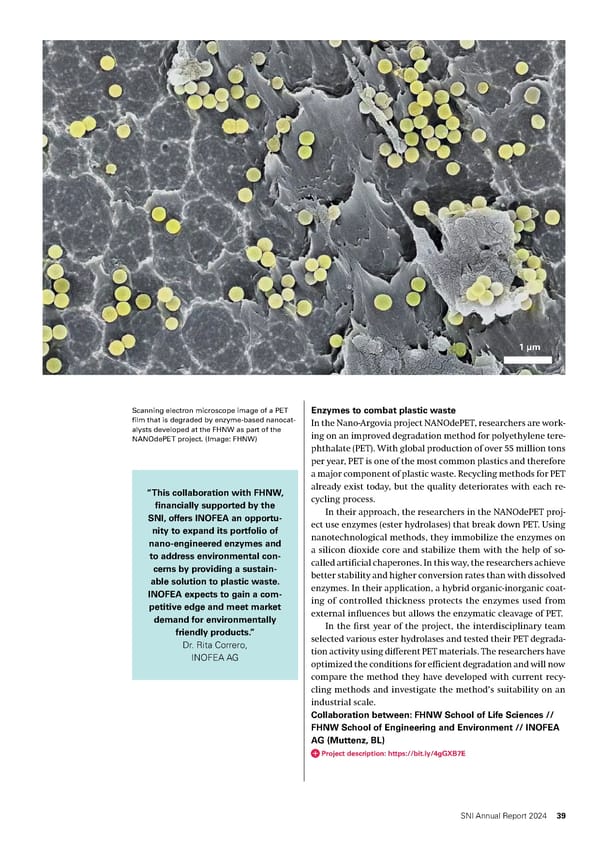
Safe and targeted transport of new therapeutics In the Nano-Argovia project SmartCoat, research- into cancer cells ers are using SmartCoats™ (shown in green in As part of the Nano-Argovia project SmartCoat, researchers have the image on the right) to transport RNA-based drugs precisely and safely into cancer cells developed an innovative method for transporting RNA-based (shown with a blue-colored cell nucleus and red drugs precisely and safely into tumor tissue. This involves the actin in the cytoplasm in the image on the left). use of novel nanoparticles called SmartCoats™, which protec- The RNA fragments introduced into the tumor cells are intended to switch-off cancer-causing tively coat short RNA sequences known as small interfering genes known as oncogenes, thereby reducing tu- RNA (siRNA) and introduce them directly into cancer cells. mor growth. (Image: FHNW Muttenz) The SmartCoats protect the siRNA from enzymatic degra- dation during transport and prevent unwanted reactions with immune cells. In tumor tissue, the SmartCoats then bind to “The ongoing Nano-Argovia specific receptors on the surface of cancer cells, allowing the project with FHNW and PSI is a SmartCoat-siRNA complexes to be taken up into the cells. Once cornerstone of our innovation there, the SmartCoat detaches from the siRNA, which can then at Palto Therapeutics.” “knock down” cancer-causing genes known as oncogenes and Dr. William L. Wishart, thereby reduce tumor growth. Palto Therapeutics AG In the second year of the project, the team used computer modelling to further optimize the SmartCoat nanoparticles. The structure of the particles is now more stable, their siRNA binding is stronger, and their uptake by cancer cells is better. Further studies can now follow under the leadership of Palto Therapeutics AG with a view to optimizing the effect of the particles on tumor growth, enabling precise and personalized treatment of life-threatening diseases such as cancer. Collaboration between: FHNW School of Life Sciences // Paul Scherrer Institute PSI // Palto Therapeutics AG (Allschwil, BL) Project description: https://bit.ly/4bR9s1Z 40 SNI Annual Report 2024
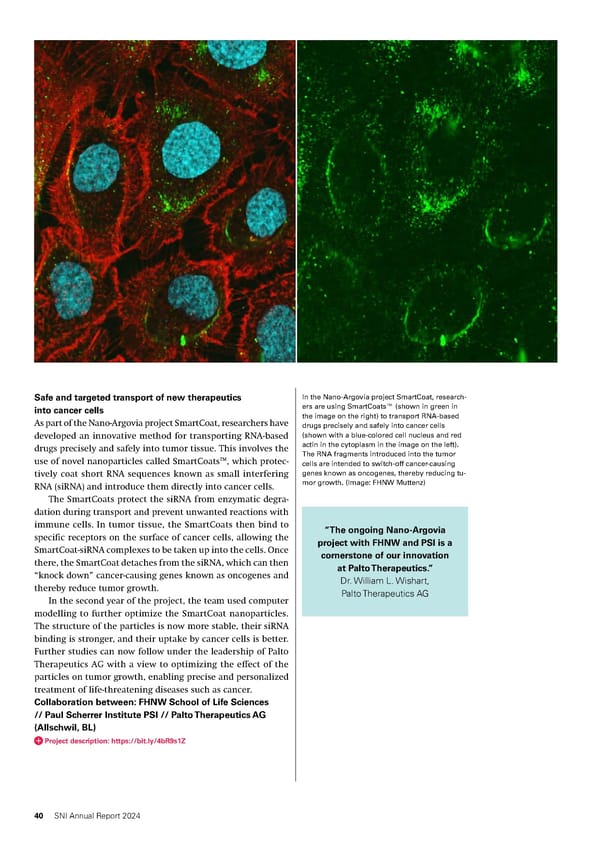
Researchers from the UZB of the University of Nanostructured dental implants made of ceramics Basel, the FHNW School of Life Sciences and the In the Nano-Argovia project ZIRYT, an interdisciplinary team is Institut Straumann exchange ideas at regular investigating how a nanostructured surface can be used to pro- team meetings. In this way, the researchers in- volved ensure effective interdisciplinary collabo- duce ceramic dental implants made of zirconium oxide. The ration. aim is to offer an aesthetically pleasing and metal-free alterna- tive to titanium implants. The researchers began by heat-treating zirconium oxide in “We’re confident that zirco- a targeted manner to produce a nanostructured surface. Under nium oxide-based dental im- the influence of heat, a characteristic structure forms on the plants can achieve a significant surface of zirconium oxide based on the existing crystalline market share in the coming structure of the material. This surface structure is intended to years. Accordingly, we’re partic- ensure effective integration of the implant into bone. ularly interested in the results First, the researchers developed and tested various protocols of the ZIRYT project, which has for producing the nanostructures. They then used various ana- the potential to optimize both lytical methods to begin characterizing the different structures the complexity of the produc- and completed the necessary preparations for investigating the tion process and the clinical interaction between the implant material and various cell lines outcomes of our products — in the second year of the project. By doing so, they plan to de- for the benefit of patients. Our termine the ideal surface structure and define its production long-standing and successful conditions. The project therefore aims to facilitate the produc- collaboration with UZB, the tion of next-generation zirconium dioxide dental implants so University of Basel and FHNW that they can benefit as many patients as possible. reinforces our commitment to Collaboration between: University Center for Dental Med- supporting these centers of icine Basel (UZB) // FHNW School of Life Sciences // Insti- excellence in their outstanding tut Straumann AG (Basel) research work on an ongoing Project description: https://bit.ly/3WYlkJB basis.” Dr. Raphael Wagner, Institut Straumann AG SNI Annual Report 2024 41
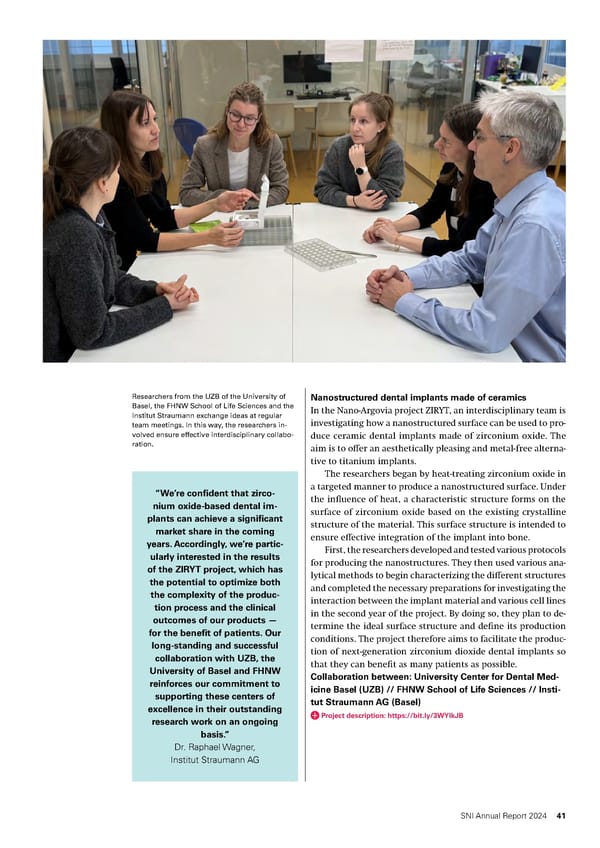
Fototermin 20.1. Smooth mirrors for X-rays In the PICO cleanroom at Park Innovaare, re- As part of the Nano-Argovia project CAPOFOX, researchers have searchers in the Nano-Argovia project CAPOFOX developed new lithographic approaches to the production of are processing light-sensitive coatings on wafers in order to subsequently produce the improved micro-optical components from polymers. These components X-ray capillary optics. are known as capillary optics and consist of elongated cylindri- cal mirrors that precisely concentrate light on a point by means of reflection. To enable the use of both ultraviolet and X-rays, the mirrors need to have an extremely low surface roughness. “Over the last year, the For this work, the interdisciplinary team combined aspects CAPOFOX project has led to of tool engineering, laser technology, design and materials sci- remarkable improvements in ence to allow the production of these extremely smooth poly- the reduction of surface rough- mer structures. In the second year of the project, the research- ness, allowing us to obtain very ers succeeded in determining the origins of the roughness and smooth surfaces that signifi- in producing the first components. This work will serve as the cantly improve our product basis for producing X-ray capillaries with improved surfaces in development work. This innova- the coming year. tive approach not only ensures Collaboration between: Paul Scherrer Institute PSI // high performance but also FHNW School of Life Sciences // XRnanotech AG (Villigen, opens the door to effective fu- AG) ture applications. We’re Project description: https://bit.ly/3ThvoMr delighted to play a part in such transformative improvements.” Dr. Florian Döring, XRnanotech AG 42 SNI Annual Report 2024
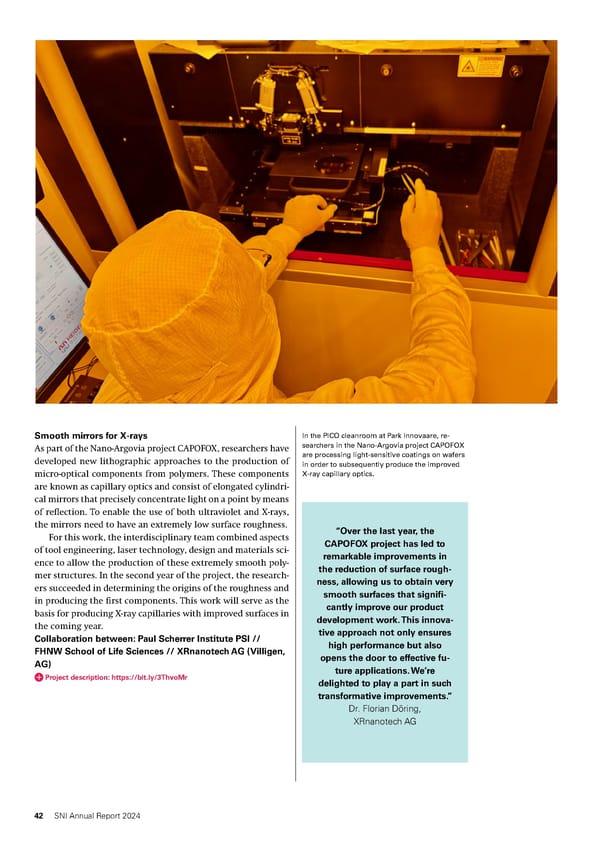
In the Nano-Argovia project NanoFemto Tweezers, Body-on-chip thanks to efficient femtosecond lasers researchers have combined a novel femtosecond as optical tweezers laser with nano-optical elements to create optical As part of the Nano-Argovia project NanoFemto Tweezers, re- tweezers that can be used to assemble different cell types into biological tissue. searchers have developed optical tweezers that make it possible to precisely arrange different cell types —including nerve cells — in a very small space. The interdisciplinary team realized these optical traps by combining developments in femtosecond “The Nano-Argovia project lasers and nano-optical elements. NanoFemto Tweezers offers us At the end of the project’s second year, thanks to the team’s the chance to investigate and outstanding expertise and effective collaboration, the research- further develop one of our in- ers moved microbeads and various cell types in a controlled novative lasers for various manner — and they will soon assemble them into a complex novel applications — including organ system on a microscopic surface (body-on-chip) by using optical tweezers, multiphoton the developed optical tweezers as a 3D printer. In the future, imaging and the 3D printing of this technology could be used to investigate the effect of drugs biological tissue on the on several organ systems directly on a chip, for example. micrometer scale.” Collaboration between: FHNW School of Engineering and Stephan von Wolff, Environment // FHNW School of Life Sciences // TLD Pho- TLD Photonics AG tonics AG (Wettingen, AG) Project description: https://bit.ly/3I6gAKd SNI Annual Report 2024 43
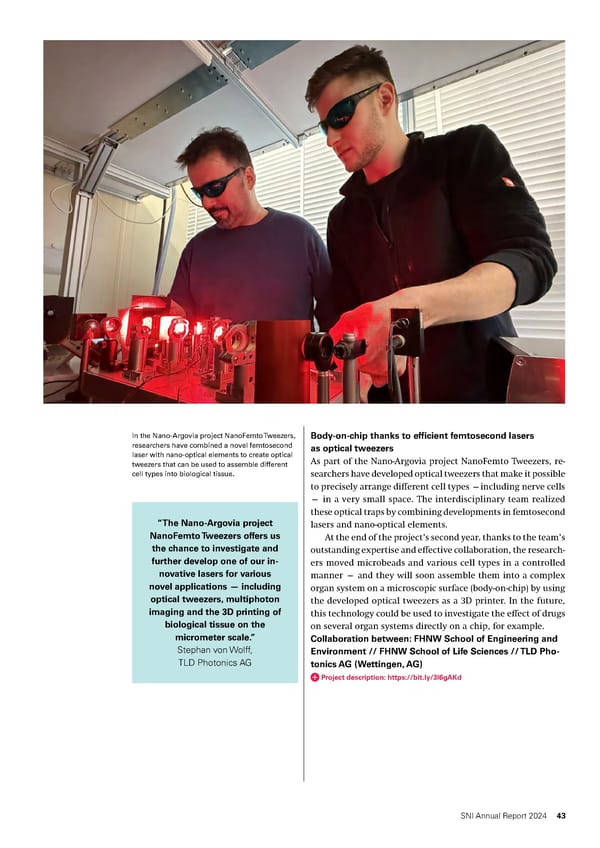
Innovative current sensor to the highest quality standards The team in the Nano-Argovia project NanoHigh- As part of the Nano-Argovia project NanoHighSens, researchers Sens produced an improved prototype of a new have developed a new type of current sensor that surpasses type of current sensor. (Image: J. Pascal and H. Nicolas, FHNW) existing technologies in terms of bandwidth and resolution and sets new standards for power quality measuring devices. The system is based on seven small magnetometers sur- rounding the current conductor. Each magnetometer is based on 100 magnetic tunnel junctions placed within an area of only “The results of the Nano- 100 μm x 100 μm. The improved resolution and optimized sig- HighSens project provide the nal-to-noise ratio are achieved by averaging 100 magnetic field fundamental basis for a new, measurements per sensor. innovative generation of electri- In the second year of the project, the interdisciplinary team cal high-current sensors.” produced an improved prototype of the sensor based on the Max Ulrich knowledge gained in the first project year and then character- Camille Bauer Metrawatt AG ized this prototype. In addition, the industrial partner Camille Bauer Metrawatt integrated and tested the device in its test area. Collaboration between: FHNW School of Life Sciences // FHNW School of Engineering and Environment // Camille Bauer Metrawatt AG (Wohlen, AG) Project description: https://bit.ly/48ru0uQ 44 SNI Annual Report 2024
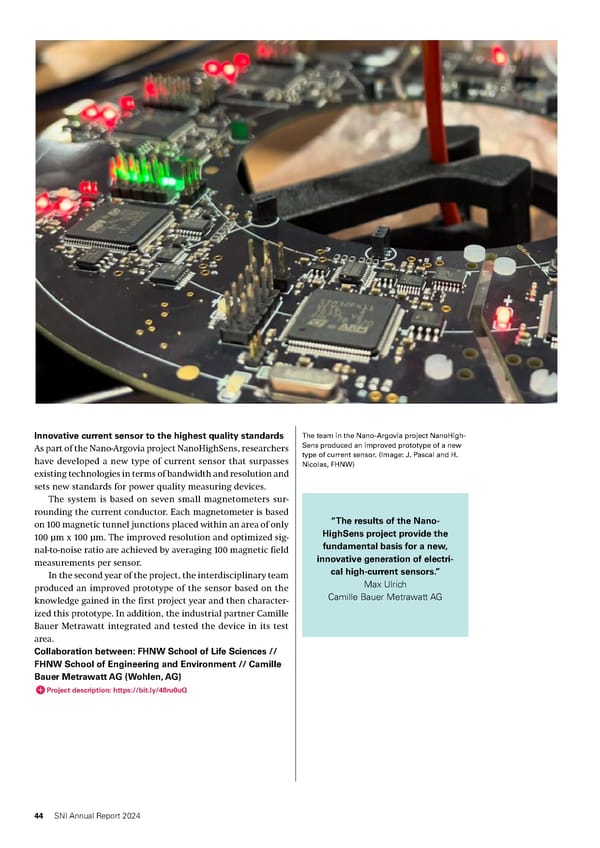
Researchers in the Nano-Argovia project QSBI Quantum sensor for brain diagnostics are working on the development of a quantum In the Nano-Argovia project QSBI, an interdisciplinary team sensor for studying brain activity with the help of investigated how brain activity can be analyzed precisely using nitrogen-vacancy centers in diamonds. As part of the project, they have built an optical laser setup quantum sensors based on diamonds with nitrogen-vacancy to evaluate the impact of nanopatterning of the (NV) centers. The aim of the project was to improve the existing diamond surface. (Image: PSI) method of magnetoencephalography by using the NV centers to detect the weak magnetic fields generated by the brain. In addition, the researchers developed an algorithm that helps to create a three-dimensional map of brain activity from the mea- “The QSBI project was very surement data. successful and allowed Qnami To optimize the signal-to-noise ratio, the researchers struc- to gain critical insights into tured the diamond surface with photonic crystals on a nano- several aspects of the sensor meter scale and optimized the production process. They also solution we’re developing. improved and tested algorithms for machine learning. This Thanks to the Nano-Argovia makes it easier to process the data, enabling a highly accurate program, we benefited from and robust reconstruction of 3D brain activity. the expert work of a multi- Collaboration between: Paul Scherrer Institute PSI // CSEM disciplinary consortium and SA Allschwil // Qnami AG (Muttenz, BL) made progress on both the Project description: https://bit.ly/47BuEFD device and software side.” Dr. Mathieu Munsch, Qnami AG SNI Annual Report 2024 45
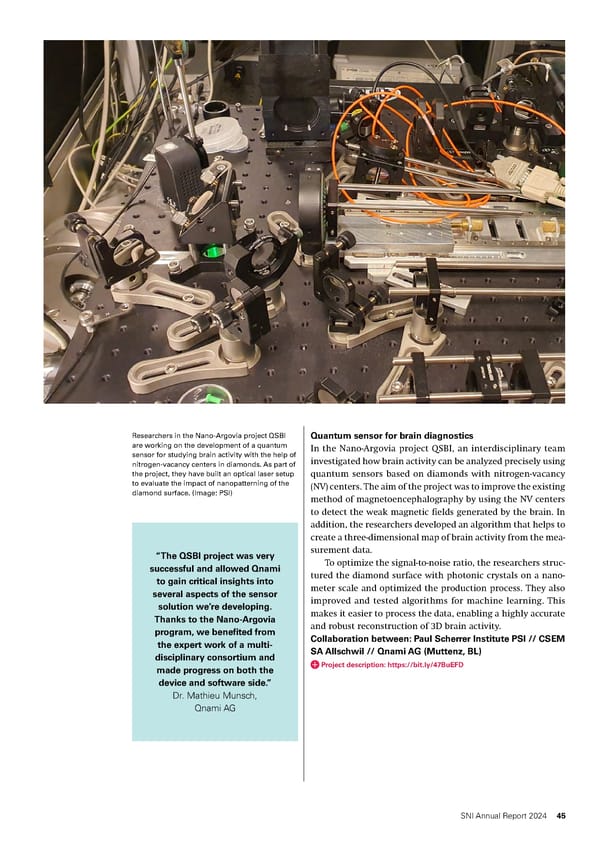
Electron diffraction for protein structural biology In the Nano-Argovia project ProtEDinNanoxtals, The Nano-Argovia project ProtEDinNanoxtals uses electron dif- the researchers first produce nanocrystals. These fraction to unlock the secrets of hydrogen atoms’ roles in pro- are then used to create a detailed diffraction pat- tern that shows the exact arrangement of the at- tein function and the interactions between proteins and li- oms in the protein molecule. gands. This cutting-edge experimental research aims at shed- ding light on the atomic-level structure of proteins, paving the way for a deeper understanding of essential biological processes and driving innovation in drug development. “Electron diffraction shows Using high-energy electrons, the team generates detailed potential as a vital complemen- diffraction patterns that will reveal the precise arrangement of tary technology for nano- atoms from thousands of protein molecules arranged in a nano- crystals, providing additional crystal. This pioneering approach will enable the decoding of structural detail such as the molecular structures with unparalleled precision, especially position of hydrogen atoms. with regard to the position of hydrogen atoms. This information is crucial to To validate and refine their method, the researchers need the design of better drugs for first to explore a range of well-characterized model proteins of membrane protein targets.” varying sizes and functions. A first milestone was reached with Dr. Robert Cheng, electron diffraction images to 1.2 Å resolution. The team of leadXpro AG experts in physics and biology will concurrently and progres- sively improve both the electron microscope settings and the samples, and will establish a pipeline to ultimately analyze pharmaceutically significant membrane proteins — an ambi- tious step toward understanding these critical biomolecules. Locating the position of hydrogen atoms in membrane protein is currently beyond the realm of other experimental techniques including both X-ray crystallography and cryo-EM. In the future, additional membrane proteins will be studied, broadening the use of the electron diffraction technique and offering streamlined sample preparation. By contributing their 46 SNI Annual Report 2024
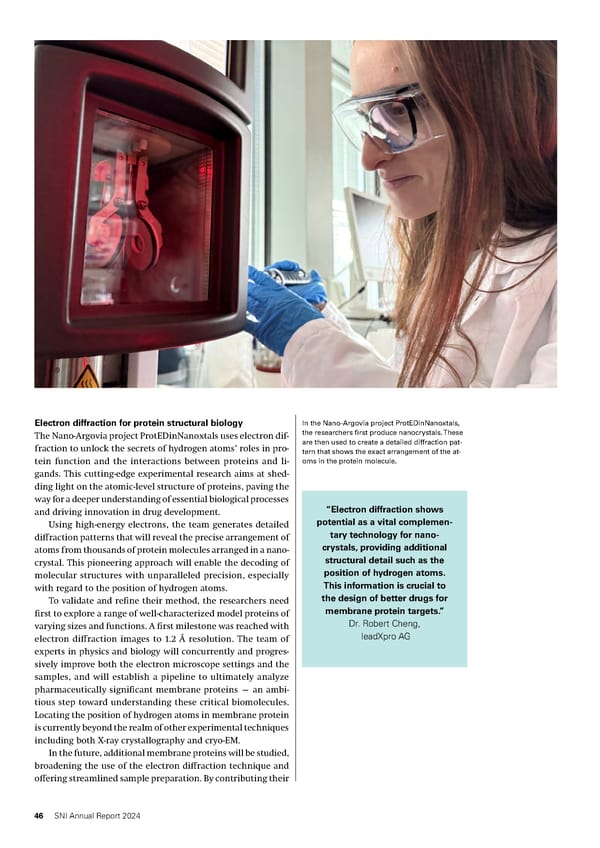
Electron diffraction can be used to elucidate the findings to under-represented structural databases, the consor- structure of nanocrystals. In the Nano-Argovia tium is not only filling vital gaps in scientific knowledge but project ProtEDinNanoxtals, the researchers also also propelling the discovery of new therapeutic agents. With want to analyze the position of hydrogen mole- cules in membrane proteins. their results, they are also helping to uncover the mechanisms of action of potential active pharmaceutical ingredients. Collaboration between: Paul Scherrer Institute PSI // Bioz- entrum, University of Basel // leadXpro AG (Villigen, AG) // “ELDICO was the first company ELDICO Scientific AG (Villigen, AG) to make commercially available Project description: https://bit.ly/3Qh8wdq systems dedicated to electron diffraction crystallography. In this project, jointly with our partners, we will be now driv- ing the technology further.” Dr. Gunther Steinfeld, ELDICO Scientific AG SNI Annual Report 2024 47

Service, research and teaching The members of the Nano Technology Center offer an excellent service in the field of nanoimaging and nanofabrication. They are also involved in research projects and train young scientists. During one of the block courses in the Nano Imaging Lab, Natalie Walser took this picture of the surface of kale and submitted it for the Nano Image Award competition 2024. 48 SNI Annual Report 2024
SNI Annual Report 2024 49
Nano Technology Center: Partners in research and teaching In the future, the SNI’s focus will be on the areas of nanoimaging and nanofabrication. A key part of this orientation is the Nano Technology Center, which was founded in 2022 and consists of the Nano Imaging Lab (NI Lab) and the Nano Fabrication Lab (NF Lab). These two groups are available both to partners from the network and to external custom- ers in order to provide services and engage in research partnerships. The teams continually expand and renew their infrastructure in order to meet the requirements of customers, to remain competitive and to keep up with the state of the art. Both groups are also engaged in teaching and outreach activities and make a key contribution to bringing insights into the micro and nanoworld to a wide audience. In 2024, the Nano Imaging Lab, with its six members of staff led by the nanoscientist Dr. Marcus Wyss, processed 180 orders from 130 differ- ent customers. Of these wide-ranging projects, which often lasted sev- eral days or weeks, 86% originated from within the SNI network or from external research institutions, while some 14% were commis- sioned by national and international industrial companies. The laboratories and clean rooms of the Nano Fabrication Lab were used by 73 different users in 2024. Led by physicist Dr. Gerard Gadea, the lab’s four-person team enabled researchers from a total of 10 re- search groups from the University of Basel and from two companies to carry out wide-ranging projects at the Nano Fabrication Lab. In 2024, the team also trained two new members of staff and focused on opti- mizing organizational procedures and improving communication with users. Nano Technology Center: https://nanoscience.unibas.ch/en/services/ 50 SNI Annual Report 2024
Alexander Vogel from the NI Lab takes the Nano Imaging Lab first measurements using the new scanning A valuable partner for research electron microscope. In 2024, the Nano Imaging Lab (NI Lab) helped numerous research groups with the imaging, analysis and modification of nanoscale structures. The team provided valuable support to researchers seeking to answer questions that were not only relevant to com- panies but also led to several interesting publications. Overall, the tendency for the Nano Imaging Lab to evolve from a pure service unit into a valuable partner for research grew stronger in 2024 — as demonstrated by the greater number of scientific publications involving NI Lab staff. In collaboration with the ANAXAM Technology Transfer Cen- ter, for example, the NI Lab was able to apply its expertise relat- ing to the analysis of ceramic coatings for medical devices from a materials science perspective. This project revolved around a new ceramic coating with the three components aluminum ox- ide (Al2O3), titanium dioxide (TiO2) and zirconium dioxide (ZrO2). This coating was applied to a titanium alloy using a special tech- nique known as atmospheric plasma spraying. For Gulhfi AG (Wohlen, AG), an international manufacturer of surface technol- ogy, it was then important to clarify the robustness of these new coatings under loading. SNI Annual Report 2024 51

The team from the NI Lab used an ion beam to cut The NI Lab’s analyses led to the identification of the crystal struc- the new coating (left: top view) into sections, ture of the two key phases (alpha-Al O and m-ZrO ). Further anal- which they analyzed using a transmission electron 2 3 2 microscope (right: cross section of coating). Re- yses by Professor Michael de Wild at the FHNW School of Life searchers were then able to identify the different Sciences then demonstrated that the 400-micrometer-thick coat- components using energy-dispersive X-ray analy- ing was highly resistant and remained intact even when sub- sis (EDX). (Image: Nano Imaging Lab, SNI, Univer- jected to scratch testing. The coating is therefore of particular sity of Basel) interest for use in high-wear applications — such as medical devices. In collaboration with Professor Martin Kuentz from the FHNW School of Life Sciences, the Nano Imaging Lab made a key contribution to drug development in a project centering around pharmaceutical formulations that were difÏcult to keep stable in the amorphous (glass-like) state. The aim was to design a com- putational strategy that could be used to select suitable additives for stabilization before the drug is actually developed. With a view to analyzing these predictions experimentally, the researchers tested two active ingredients, which were pressed into an elongated shape together with a polymer and two addi- tives (dl-malic acid and l-acetic acid) using a technique known as hot-melt extrusion before being placed in storage. The team from the NI Lab used laser and atomic force microscopes to examine the surfaces of the various products, allowing researchers to make an informed evaluation of the best active ingredient-poly- mer mixtures in terms of stability and durability. For years, the NI Lab has been engaged in trinational projects relating to sustainable viticulture. In 2024, as part of the WiVitis project launched in 2023, researchers in Basel analyzed the sur- face properties and structure of waxes found on the berries of certain fungi-resistant vine varieties. These analyses aimed to further the development of concepts that help wineries tackle the challenges of climate change. The instruments used at the NI Lab must be continuously renewed and expanded with a view to not only constantly im- proving the lab’s services and its own research but also adapting the infrastructure in line with demand. In 2024, the NI Lab team installed and commissioned a new scanning electron microscope (Zeiss FIB-SEM Crossbeam 540), which is equipped with a focused 52 SNI Annual Report 2024
ion beam (FIB). This enables the high-resolution visualization of The NI Lab team used atomic force micros- micro and nanostructures and allows the accurate machining of copy (left) and 3D laser scanning microscopy materials, such as to create the precise sections needed to pro- (right) to examine the surface of various compositions of solid drug formulations, duce ultrathin samples for transmission electron microscopy. helping researchers evaluate the best active The microscope allows the NI Lab team to meet the requirements ingredient-polymer mixture in terms of sta- of various different disciplines, such as quantum, materials or bility and durability. (Image: Nano Imaging Lab, SNI, University of Basel) environmental science or the life sciences. “Many new drug candidates can only be developed into a finished dosage form with the help of special formulation techniques. On multiple occasions during applied research into these dosage forms, the Nano Imaging Lab helped us to gain a better understanding of formulations and to identify practical stability problems in good time using various different analyses.” Professor Martin Kuentz, FHNW School of Life Sciences “The electron microscopy facilities at the SNI make an important contribution, acting as a complement to ANAXAM’s material analytics.” Dr. Christian Grünzweig, ANAXAM Technology Transfer Center SNI Annual Report 2024 53
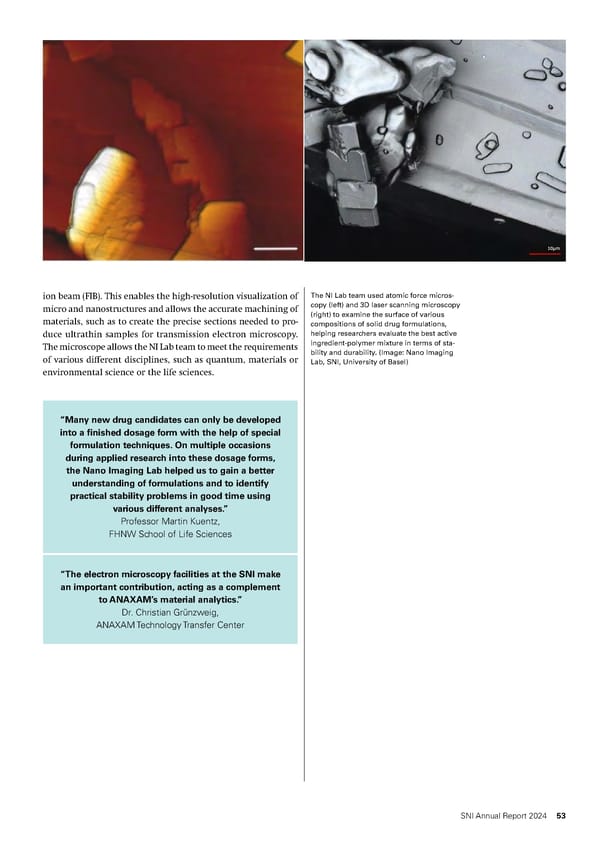
Nano Fabrication Lab Point of contact for the production The staff of the Nano Fabrication Lab largely of tiny structures carry out their work in clean rooms belong- ing to the NF Lab. These facilities provide controlled conditions with minimized particle concentrations that are essential for the pro- In 2024, work at the Nano Fabrication Lab (NF Lab) was carried duction and machining of micro and nano- out by over 70 researchers from the University of Basel and from structured materials. the two companies Nanosurf and Qnami. Although researchers use the lab’s instruments largely independently, they are reliant on the NF Lab team’s experts when it comes to the intensive “The NF Lab and other part- training, servicing and maintenance work on these heavily used ners help us to obtain the instruments, which play a vital role in their research projects. best possible nanopore For the four-person NF Lab team, 2024 was dominated by the chips for our highly sensi- training of two new part-time employees and the improvement tive experiments with of organizational structures. For example, responsibilities for single-molecule resolution.” the diverse range of equipment were redistributed within the Professor Sonja Schmid, team, so that tasks such as maintenance, repair and the training Department of Chemistry, of new users are now spread across the four members of staff. University of Basel The team also introduced a new accounting system that allows for fairer billing of costs arising as a function of instrument use — based on the cost per hour or cost per process. Moreover, the team implemented improved guidelines on cleanliness and safety in the clean room in 2024, reducing the particle concen- tration and the risk of accidents. The year 2024 also saw the team improve various aspects of communication. For example, since the section of the NF Lab’s clean room space that entered operation in 2023 is located in the building of the Department of Biosystems Science and En- gineering of ETH Zurich in Basel (D-BSSE), there are regular meet- 54 SNI Annual Report 2024
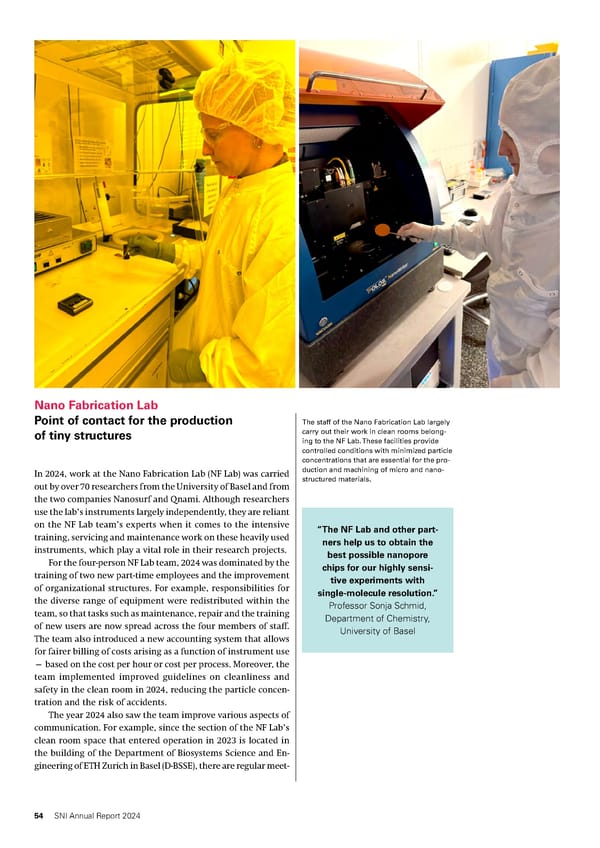
The metal evaporator installed in 2023 is now ings between the head of the Nano Fabrication Lab, Dr. Gerard a much-used device at the Nano Fabrication Gadea, and D-BSSE’s clean room managers. Regular discussions Lab and requires frequent cleaning and ser- also take place within the team, with all of the lab’s users, and vicing by NF Lab staff so that it is available to users at all times. with the professors from the Department of Physics, helping the NF Lab team to ensure that they can respond quickly to un- resolved questions, problems and requirements. The lab has also succeeded in improving its visibility and presenting itself as an “We’re one of the main users open platform for collaboration by publishing a price list setting of the NF Lab, and our out the costs of using its instruments for external users and by research is dependent on the introducing a new team email address ([email protected]) as lab. We particularly benefit well as a shorter website URL (nanofabrication.unibas.ch). from the opportunities Researchers use the Nano Fabrication Lab to work on provided by the new instru- wide-ranging projects. Although they use various different in- ments for electron beam struments and require different forms of assistance, the NF Lab lithography and metal team is on hand to help all of them with a view to creating the evaporation.” best possible conditions for their work. Professor Andrea Hofmann, The group led by Professor Sonja Schmid (Department of Department of Physics, Chemistry) produces chips with glass nanopores at the NF Lab University of Basel in order to investigate the dynamics of individual molecules. Although there are established, standard nanofabrication pro- cedures for silicon chips, these procedures have several disad- vantages when it comes to the desired applications. Producing the nanopore chips from glass requires a certain degree of ad- aptation, which the NF Lab helps the researchers achieve. The team led by Professor Andrea Hofmann (Department of Physics) uses the NF Lab to produce various nanoscale samples, which they then put to use in their quantum research. These samples include semiconductor quantum dots, Josephson junc- SNI Annual Report 2024 55
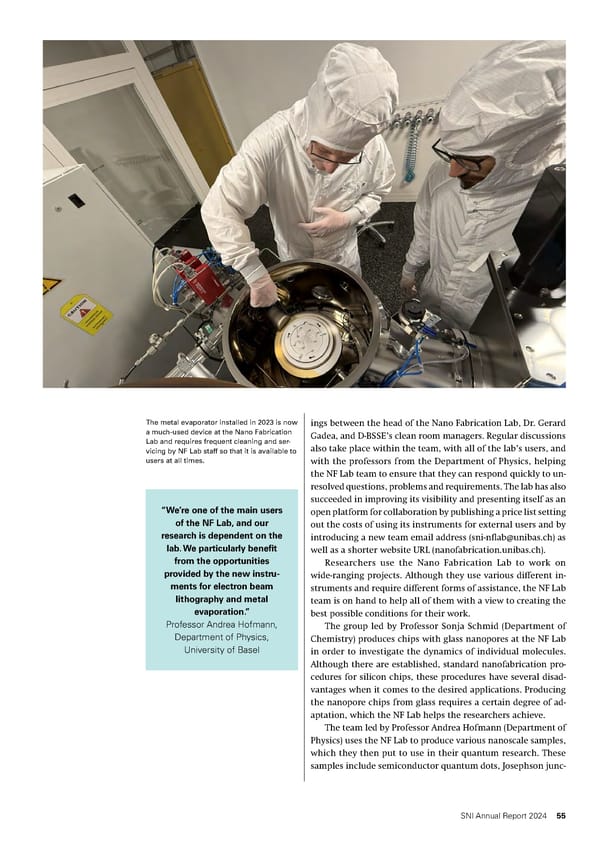
tions and one-dimensional channels in bilayer graphene. The Researchers can use the heating furnace to improve the NF Lab provides the researchers with the clean environment properties of components from the quantum sciences, such they need in order to produce these samples. as silicon-germanium qubits or quantum sensors based on nitrogen-vacancy centers in diamonds. Over the last year, the Quantum Sensing group led by Pro- fessor Patrick Maletinsky (Department of Physics) made inten- sive use of the NF Lab in order to produce and further optimize nanoscale quantum sensors, whose principal application is in “The team of the Nano Fabrication qualitative magnetic imaging on the nanoscale. For example, Lab is invaluable for our research at the sensors are used in the development and improvement of the interface between quantum and novel magnetic storage media for computer applications and to nanotechnology. They not only ensure analyze interesting new magnetic materials. Work at the NF Lab that the instruments are always in focused on achieving further improvements in the sensors’ per- reliable working order, but also ac- formance, functionality and robustness. tively support us in further developing The two companies Nanosurf and Qnami were also active at and optimizing our nanofabrication the NF Lab in 2024. Nanosurf worked on the preparation of processes. The team has therefore semiconductor chips that are then characterized using state-of- played a key role in driving forward the-art industrial atomic force microscopes for wafer metrology. our research projects, while also Overall, the establishment of the Nano Fabrication Lab in allowing my group members to 2022 is greatly appreciated by users, as the team allows research- concentrate fully on their scientific ers to focus on their research. work instead of spending time on maintaining instruments at the NF Lab.” Professor Patrick Maletinsky, Department of Physics, University of Basel 56 SNI Annual Report 2024
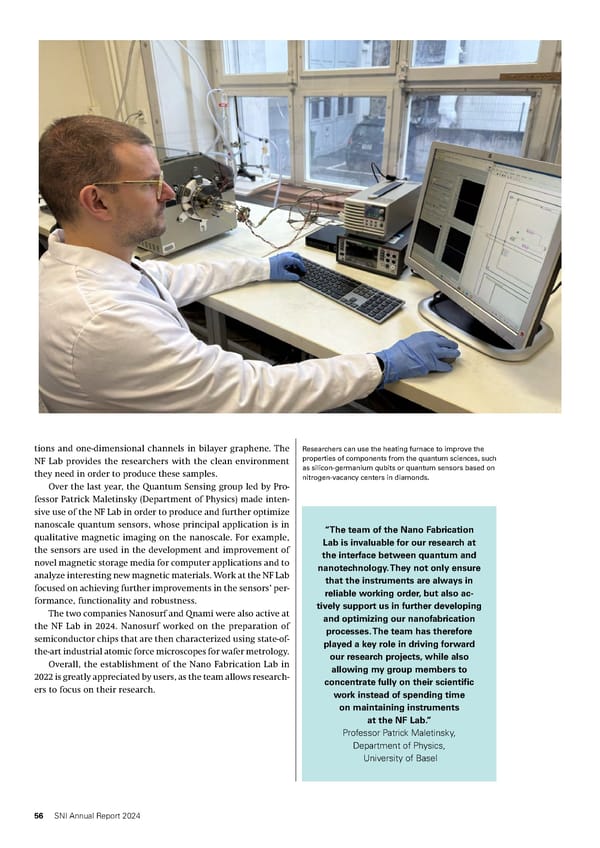
Nano Technology Center The event “TecDay meets Swiss NanoConvention” wel- Active in teaching and outreach comed groups of schoolchildren to the SNI’s Nano Tech- nology Center in June 2024. Here, Marcus Wyss and Mon- ica Schönenberger explained various methods used by the Nano Imaging Lab to image and analyze the micro The two teams from the NI Lab and the NF Lab also play an active and nanoworld. (Image: Nano Imaging Lab, SNI, Universi- ty of Basel) role in teaching and SNI outreach programs. In 2024, the Volks- hochschule beider Basel (VHSBB) offered a series of talks and an excursion to the NI Lab in collaboration with the SNI. The course was well received by all participants and is to be re- peated in fall semester 2025. In 2024, the two groups gave the Baselland Nature Research Society (NGBL) a tour of the Nano Technology Center. Other visitor groups were also warmly wel- comed over the course of the year and, thanks to the team’s efforts, gained fascinating insights into the imaging and fabri- cation of micro and nanostructures. Since 2024, the two team leaders Gerard Gadea and Marcus Wyss have offered a lecture course on nanoimaging and nano- fabrication for bachelor’s and master’s students. Moreover, stu- dents of biology and the nanosciences have the opportunity to immerse themselves deeper in the topic of nanoimaging as part of a block course. In 2024, the NI Lab team restructured these courses and produced an extensive handbook. Another highlight of the year was the User Event, which was attended by over 40 participants. Organized by the NI Lab on an annual basis, this event provides current and potential users with insights into the lab’s wide-ranging analytical capabilities. SNI Annual Report 2024 57
58 SNI Annual Report 2024
A fascinating world of tiny structures They say a picture is worth a thousand words — although, in the nanosciences, it often takes quite a few words to describe what exactly we’re looking at in images showing structures or objects from the micro or nanoworld. Nevertheless, these beautiful microscopic images are a never-ending source of fascination. The Nano Image Award competition advertised by the SNI means that we receive beautiful images from research- ers from our network every year. These images help us to appeal to a wider audience and generate curiosity about the nanoworld. This “eye” was one of the winning images in 2024 and shows an unexpected circular defect on a silicon dioxide chip. It was noticed by SNI doctoral student Jibin N. Sunil while he was examining two-dimensional mono- layers using a dark-field microscope. (Image: Jibin N. Sunil, Department of Physics, University of Basel) SNI Annual Report 2024 59
Network: Achieving joint goals through interdisciplinary collaboration The SNI is an interdisciplinary network in which researchers from var- ious research organizations in Northwestern Switzerland carry out re- search into the nanosciences and nanotechnology in order to drive advances for the benefit of the general public. Partner institutions belonging to the network include the University of Basel, with its Departments of Biomedicine, Chemistry, Physics, Pharmaceutical Sciences and Environmental Sciences and the Bio- zentrum; the FHNW School of Life Sciences in Muttenz and School of Engineering and Environment in Windisch; the Paul Scherrer Institute; the Department of Biosystems Science and Engineering of ETH Zu - rich in Basel; the Centre Suisse d’Electronique et de Microtechnique (CSEM) in Allschwil; and the technology transfer centers ANAXAM and Swiss PIC. The broader network also includes the Hightech Zen - trum Aargau in Brugg and Basel Area Business & Innovation, with whom we collaborate to promote knowledge and technology transfer. In 2024, the management team worked with internal and external experts to develop a strategy for the next 10 years of the SNI net- work. One key pillar of this strategy is to reinforce collaboration be- tween SNI members across the boundaries of different disciplines and institutions. This goal will benefit from events organized by the SNI management as well as optimum networking and a regular ex- change of information among members. 60 SNI Annual Report 2024
Strategy 2024–2034 Close collaboration by all partners is vital for the Geared toward a successful success of an interdisciplinary network such as the shared future SNI. The aim for the future is to strengthen identifi- cation with the SNI network among its members, to create a stronger sense of “we” and to communicate At the end of May 2024, the Argovia Committee ap- the SNI’s achievements together. proved the strategy paper for 2024–2034. It was de- In order to compete with the best nanoscience veloped with the involvement of the SNI manage- centers in the world, we must adapt our infrastruc- ment, external and internal experts, and members ture to the ever-increasing technological demands of the SNI Executive Committee. Using this strategy of the coming years. We will also continue to mod- as a guide, the SNI will position and establish itself ernize the training of young scientists and make the over the coming years so that we can put our extraor- way in which we present information about our ac- dinary expertise in the nanosciences and nanotech- tivities increasingly more attractive. nology to use in addressing the challenges facing On the one hand, the SNI’s work will impact so- society — and make the SNI a lighthouse for re- ciety through successful research on issues for which search, education and innovation in the nanosci- nanotechnologies offer solutions. On the other hand, ences. The key guiding principles for achieving our it will have an impact by providing specialized ser- goals are to focus, collaborate, adapt and impact. vices beyond the network and, lastly, by training Over the next decade, the SNI will focus on the excellent young scientists and active outreach. core areas of nanoimaging and nanofabrication by Strategy paper 2024–2034: https://bit.ly/3WY3Dts building on our roots and experience while steadily Video on the SNI’s strategy featuring members of the Execu- consolidating and expanding our infrastructure and tive Committee: https://youtu.be/ooINp3M1ngU knowledge in these areas. We will involve all areas of the SNI — including fundamental and applied re- search, the service units (the Nano Technology Cen- ter) and the educational program — within this focus in order to help overcome challenges in the fields of materials science, quantum science, the life sciences, medicine and the environment. For the SNI, the devel- opment of its Strategy 2024–2034 began with a workshop to which we invited internal and external experts from various nanocenters. SNI Annual Report 2024 61
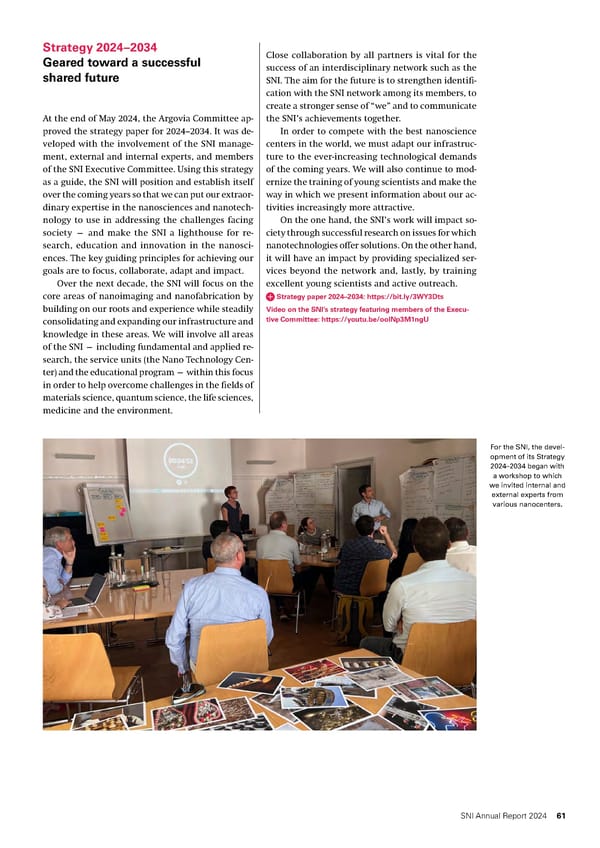
The NanoTec Apéro (top left), the Swiss NanoConvention and the SNI Annual Event (bottom right) focus on the exchange of ideas regarding current research projects and the making and strength- ening of contacts. Active networking The annual Swiss NanoConvention (SNC) provides Bringing researchers together for opportunities for networking beyond the borders of information and exchange the SNI network — particularly when the SNI orga- nizes the convention in Basel and can use invitations to cultivate contacts with international researchers. Within the SNI network, interdisciplinary exchange In 2024, the SNI team once again succeeded in bring- takes place on various levels. Project teams meet ing together leading scientists from Switzerland and regularly to discuss their respective lines of research. abroad and in organizing an inspiring SNC with Meetings are also essential at a cross-institutional some 300 participants. level so that SNI members have the opportunity to The SNI team uses various platforms to dissemi- discuss and generate ideas for collaborative projects. nate information within the network. As well as be- Once a year, all members come together for the An- ing active on various social media channels, the SNI nual Event, which has been held at Lake Hallwil in regularly reports on projects and activities via the the Canton of Aargau since 2023. Running from online magazine SNI INSight. In 2024, the SNI incor- Wednesday to Friday, the event includes scientific porated a section on funding grants into the maga- talks by doctoral students and project leaders, who zine to share details of the wide-ranging research discuss their research with one another as part of a projects of SNI members and also encourage ex- poster session and benefit from numerous opportu- change and new collaborations. nities to make new contacts and refresh old ones. Highlights from the NanoTec Apéro: https://youtube.com/ Held on an annual basis, the NanoTec Apéro re- shorts/tDm5riP0UFo volves specifically around the applied Nano-Argovia Report on the Swiss NanoConvention: https://bit.ly/4ijdCC9 projects in collaboration with industry. This is always Video Swiss NanoConvention: https://youtu.be/d2SxVeCabT0 an inspiring event and was hosted by Park Innovaare in 2024. As well as talks and posters on current proj- ects, which showcased the excellent collaboration between industry and research institutions, the around 70 participants particularly valued the tours of the Paul Scherrer Institute that were organized as part of this year’s event. 62 SNI Annual Report 2024
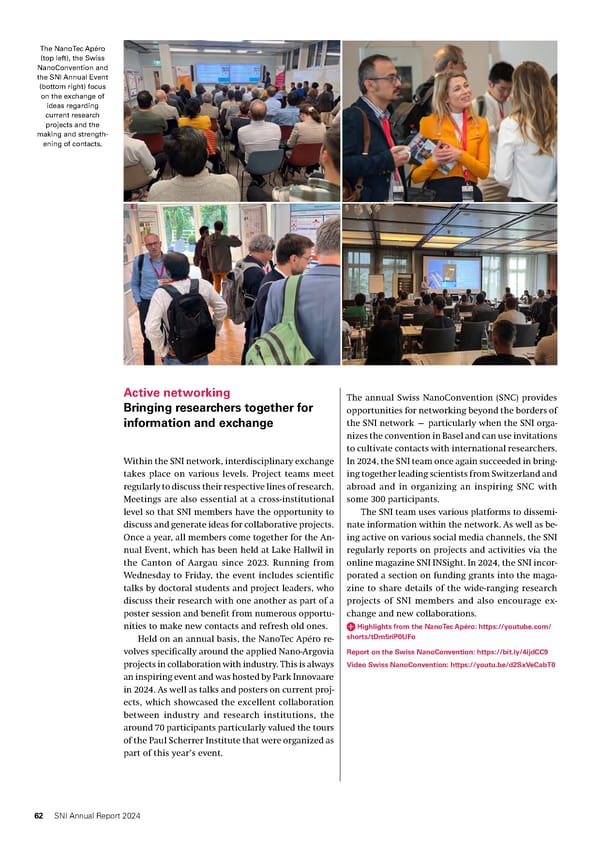
Awards and honors Christoph Gerber named Clarivate Citation Laureate This year, our honorary member Professor Christoph Gerber (Department of Physics, University of Basel) was named a Clarivate Citation Laureate for the invention of the atomic force microscope. Every September, the media group Clarivate (UK) publishes a list of scientists who are considered potential future winners of a Nobel Prize due to fre- quent citations of their work in high-ranking scientific journals. Further information: https://clarivate.com/citation-laureates/winners/ Distinction and emeritus status for Christian Schönenberger In 2024, our long-standing director and honorary member Professor Christian Schönen- berger (Department of Physics, University of Basel) was honored by the American Phys- ical Society (APS) as one of the APS Outstanding Referees for 2024. A farewell event was held in November 2024 to mark Professor Schönenberger’s retirement. Numerous long-standing colleagues who had accompanied him during his successful career took part in the event in order to wish him well in this new stage of his life. Young Fluorescence Investigator Award for Sonja Schmid In February 2024, Professor Sonja Schmid (Department of Chemistry, University of Basel) received the Young Fluorescence Investigator Award 2024 from the Biological Fluores- cence Subgroup in recognition of her work in the area of fluorescence methodologies. Further information: https://bit.ly/40pIg5q Ruzicka Prize for Murielle Delley Professor Murielle Delley (Department of Chemistry, University of Basel) is to receive the Ruzicka Prize 2024 for her work on the controlled surface modification of cobalt phos- phide with sulfur. Further information: https://bit.ly/4iBSmrf Wide-ranging grants for new research projects In 2024, SNI members were again very successful at attracting grants from national and international sources. We’ve been reporting on the various new research projects in our online magazine, SNI INSight, since 2024 in order to encourage exchange within the network. Grants for new research projects in the first half of the year: https://bit.ly/4gTZ3E5 Grants for new research projects in the second half of the year: https://bit.ly/40U4dtK SNI Annual Report 2024 63
Communication and outreach: Promotion of dialog between research and society One key task of the Swiss Nanoscience Institute is to help a wider au- dience understand the fascinating world of the nanosciences and their diverse applications. The SNI team therefore presents these often complex and demanding topics in a clear and attractive manner with a view to generating interest and encouraging discussion on an ongoing basis. Through a combination of tried-and-tested formats such as Science Days, school visits, public talks, workshops and laboratory tours, the SNI team ensures that people of all ages and backgrounds have ac- cess to nanoscience topics. Moreover, the SNI is always taking up op- portunities to test new formats for specific target groups. For exam- ple, the program for 2024 included an event called “TecDay meets Swiss NanoConvention” for high-school students from across Switzer - land. As well as events centering around personal contacts, the SNI also fo- cuses on digital communication. Our extensive and well-visited web- site and the increasing reach of our social media channels reflect the growing impact of our wide-ranging content. By the end of 2024, over 7,000 people and organizations were following the SNI’s social media channels on LinkedIn, X, Bluesky, Instagram and YouTube. Thanks to this multifaceted approach, the SNI is able to communicate scientific content in an entertaining way and thereby help people un - derstand the relevance of the nanosciences in research and everyday life. 64 SNI Annual Report 2024
At the Rüeblimärt, in the lab, in the lecture room or online Different formats for different target groups In 2024, the SNI team once again used different platforms to engage with different target groups, inform them about the nanosciences, and generate interest in the natural sciences in general. At the start of the year, for example, there was a col- laboration with Volkshochschule beider Basel in which research- Sixty high-school students took part in the event “TecDay meets Swiss ers from the SNI network offered participants insights into their NanoConvention.” various fields of science over the course of five days. The year 2024 was also the first time that the SNI took part in the Global Science Film Festival, where a six-minute video on the develop- ment of the atomic force microscope and several current appli- cations was shown to a full house at the Stadtkino Basel movie theater. Researchers from the University of Basel were the target group for a didactics workshop that the SNI team organized and in which Professor Gerald Feldman (George Washington Univer- sity, Washington, D.C., USA) shared innovative approaches to the communication of scientific content. The event tunBasel addressed a young audience, as did the numerous workshops with students from various high schools in Northwestern Switzerland. Sixty high-school students were delighted to attend “TecDay meets Swiss NanoConvention” — “At the Swiss NanoConvention, we’re learning an event organized by the SNI together with the Swiss Academy lots about nanotechnology, which plays a role in of Engineering Sciences SATW as part of the Swiss NanoCon- a surprisingly large number of areas — there’s vention (SNC). The students could choose between various mod- still so much to explore.” ules, in which researchers gave them an introduction to differ- Ylenia und Elinor, Cantonal School ent aspects of the nanosciences. Participants also spoke to SNI doctoral students about their posters and attended an SNC talk — which gave them the opportunity to experience the atmo- sphere of an international scientific conference. To round things off, the students enjoyed laboratory tours, in which they gained insights into the practical work of several working groups as- sociated with the SNI. The SNI team addressed a wider audience through activities such as those carried out on board a train as part of “MINT on the move” or at the Rüeblimärt in Aarau. Here, SNI staff offered children in particular the chance to complete small craft proj- ects and simple experiments. They also took the opportunity to inform the accompanying parents or grandparents about SNI activities and the nanosciences. On board the train, staff had a great opportunity to help children complete craft projects and experiments and to inform parents about the SNI’s activities. We report on these activities and more on our website and through various social media channels — including via videos. In June and December 2024, the SNI published its online mag- azine, SNI INSight, providing insights into different research topics and an overview of SNI activities. Further information: YouTube channel: https://bit.ly/3u9XLjv LinkedIn: https://bit.ly/3rbYP4s Bluesky: https://bsky.app/profile/sniunibas.bsky.social SNI webpage: www.nanoscience.ch SNI INSight: https://bit.ly/4jWHcis Experiments and projects: https://bit.ly/40Uw0Kr tunBasel is always a great opportunity to reach numerous children and young people, to help them perform experiments, and to show them how exciting the natural sciences can be. SNI Annual Report 2024 65
Financial report The University of Basel and the Canton of Aargau jointly founded the Argovia professors, the SNI also supports the work of three the Swiss Nanoscience Institute (SNI) in 2006. This center of ex- titular professors from the Paul Scherrer Institute: Thomas Jung, cellence for the nanosciences and nanotechnology — which en- Michel Kenzelmann and Frithjof Nolting. Together, the profes- sures nanoscience research, knowledge and technology transfer, sors received funding of some CHF 1.5 million from the SNI and excellent education for early career researchers — has long budget. since become an established institution in Northwestern Swit- Basic science is the field of research pursued by most doc- zerland. With its strategy for 2024–2034, the SNI has now also toral students at the SNI PhD School, which was founded in laid the ground for a prosperous future. Adhering to this strategy, 2012. The 40 doctoral students who formed part of the PhD we will position ourselves in the coming years so that we can School in 2024 work at various institutions within the SNI net- put our extraordinary expertise in the nanosciences and nano- work but will all earn their doctorates from the Faculty of Sci- technology to use in addressing the challenges facing society. ence at the University of Basel. In total, the outgoings for the Four guiding principles underpin the future of the SNI: fo- PhD School ran to some CHF 1.9 million. This figure includes cus, collaborate, adapt and impact. The SNI will focus on the salaries of doctoral students, consumables and PhD School core areas of nanoimaging and nanofabrication, in which we events. will include the full range of activities — from basic and applied research to the service units of the Nano Technology Center Focus on knowledge and technology transfer (Nano Imaging Lab and Nano Fabrication Lab) and the educa- The Nano-Argovia program, which has existed since the SNI was tional program. Close collaboration by all partners is vital to founded, is now a well-established platform for supporting the success of the interdisciplinary network, as is the continual knowledge and technology transfer to industry. In 2024, the SNI adaptation of infrastructure to meet ever-increasing technolog- supported ten Nano-Argovia projects with total funding in ex- ical requirements. cess of CHF 1.4 million. Project partners supplemented this fund- ing with money from public research funding instruments (e.g., Basis for innovation Innosuisse, Swiss National Science Foundation, EU funding) as At the SNI, the basic research that underpins innovation is sup- well as a total of over CHF 1.2 million in funding from the par- ported primarily by funding the two Argovia Professors Rodrick ticipating research institutions themselves. In addition, indus- Lim and Martino Poggio, both of whom make significant con- trial partners contributed around CHF 1.1 million to the various tributions to the SNI’s international reputation with their ex- research projects in the form of in-kind services. cellent research. Through their participation in national and international collaborations, the two Argovia professors to- Expansion of Nano Technology Center gether received over CHF 1.9 million in funding for their re- Founded in 2022, the Nano Technology Center is made up of search projects in addition to the funding from the SNI. Besides two units — the Nano Imaging Lab and the Nano Fabrication The following table shows the outgoings for 2024 by item of expenditure according to the financial report of the University of Basel of 26 February, 2025: Expenditure 2024 in CHF Univ. Basel Canton AG Total Management Personnel and operational costs 548’185 365’709 913’894 Overhead 650‘000 650‘000 Infrastructure Infrastructure equipment 167’717 469’285 637’002 Know-how and Techtransfer Personnel and operational costs 27’861 177’590 205’451 Nano-Argovia projects 1’431’688 1’431’688 Outreach & PR Personnel and operational costs 81’571 76’436 158’007 Support Professors Univ. Basel 607’398 770’485 1’377’883 PSI professors 125’590 125’590 Nano Curriculum Bachelor and master programs 301’326 237’941 539’267 Nano Technology Center Nano Imaging/Nano Fabrication 630’580 355’900 986’480 SNI PhD School Personnel and operational costs 744’911 1’117’367 1’862’278 Total expenditure 2024 in CHF 3’109’550 5’777’990 8’887’539 66 SNI Annual Report 2024
Lab — and provides customers from industry and academia above all at the Nano Technology Center in 2024. In the coming with comprehensive services in the areas of imaging, analysis, years, the continual expansion of this SNI service unit and the and micro and nanofabrication. structural support for research groups will continue, reducing With the strategic focus on nanoimaging and nanofabrica- the SNI’s reserves and helping to bring technical facilities up tion, it is vital for the SNI to establish and maintain modern, to a competitive level. competitive infrastructure at the Nano Technology Center’s two In the SNI’s annual financial statement, the last line reports service units. Thanks to its reserves, the SNI was in a position an amount of some CHF 4.9 million as “SNI assets per 31 De- to continue investing in equipment for the Nano Technology cember 2024, in CHF.” This does not take account of orders Center in 2024 and to carry out necessary repairs and mainte- already made for instruments that will not be delivered until nance work in a timely manner. In total, the Nano Technology 2025, including infrastructure measures at the Nano Technology Center’s budget ran to almost CHF 1 million in 2024. Center and at research groups to a value of around three quar- ters of a million francs. There is also a proportion of funding Studies and public relations for Nano-Argovia projects that has not been spent yet. A signif- In 2024, there were 76 students enrolled on the bachelor’s and icant part of this funding consists of reserves for ongoing doc- master’s program in nanosciences at the University of Basel. toral dissertation projects, as doctoral students at the SNI PhD The SNI contributes over CHF 0.5 million to the program’s fund- School take up their position over the course of the year and ing. Over the course of their studies, students receive a broad are always funded for a period of 48 months. grounding in the natural sciences and then specialize in subjects that suit their interests, meaning they are ideally equipped to Many thanks work at the interfaces between different disciplines after they We would like to extend our sincere thanks to the Finances graduate. department of the University of Basel for its excellent collabo- The work of the SNI team also includes raising awareness ration over the last year and for its efÏcient financial reporting. of the degree program as well as informing the general public Huge thanks also goes to the Cantons of Aargau, Basel-Stadt and about nanosciences and the activities of the SNI in general. To Baselland, whose ongoing commitment makes it possible for this end, SNI staff seek to engage with the public through var- the SNI to train outstanding early career researchers, gain new ious formats and use social media to bring them the latest up- scientific insights, and support companies with innovative proj- dates from the SNI. Digital channels are also used for commu- ects as we work toward building a better future. nication within the interdisciplinary network. In addition, the SNI team organizes events such as the Annual Event and the NanoTec Apéro, which are vital for ensuring an exchange of ideas within the network. In total, the costs for public relations and internal events came to less than CHF 0.2 million. Investment in modern infrastructure Thanks to saved reserves, the SNI was able to invest over CHF 0.6 million in new infrastructure at several research groups and The following table shows the income statement of SNI funds as of 31 December, 2024: SNI annual statement 2024 in CHF Univ. Basel Canton AG Total Grants 2’766’439 5‘247‘940 8’014’379 Investment income 18’947 151’625 170’571 Income 2’785’385 5’399’565 8’184’950 Expenditure 3’109’549 5’777’990 8’887’539 Annual balance 2024 (324’164) (378’425) (702’589) SNI assets per 01/01/2024 1’989’547 3’577’167 5’566’715 Annual balance (324’164) (378’425) (702’589) SNI assets per 31/12/2024 in CHF 1’665’383 3’198’742 4’864’125 SNI Annual Report 2024 67
Organization Nano Fabrication Lab Dr. G. Gadea (Head) J. Herzog Argovia Board A. Lücke Regierungsrat A. Hürzeler, Head Department of Education, X. Wildermuth Culture and Sport, Canton of Aargau Prof. Dr. A. Schenker-Wicki, President University of Basel Prof. Dr. M. Poggio, Director SNI Prof. Dr. C. Bergamaschi, President FHNW Prof. Dr. G.-L. Bona, former Director Empa Dr. W. Riess, former IBM Department Head & Coordinator Binnig & Rohrer Nanotechnology Center Prof. Dr. C. Rüegg, Director Paul Scherrer Institute SNI Executive Committee Lists of members and Prof. Dr. M. Poggio, Director SNI (PhD School) Prof. Dr. P. Maletinsky, Vice Director (Nano-Argovia program) projects 2024 Prof. Dr. S. Hiller (Biozentrum, Dean Phil. Nat.) Prof. Dr. J. Huwyler (Curriculum Nanoscience, Department of Pharmaceutical Sciences) Principal Investigators and associated members Prof. Dr. R. Y. H. Lim (Biozentrum) https://bit.ly/3QxTTCG Prof. Dr. K. Moselund (Paul Scherrer Institute) Prof. Dr. O. Tagit (University of Applied Sciences Northwestern PhD students Switzerland) https://bit.ly/4ka6vh0 Prof. Dr. O. Wenger (Department of Chemistry) C. Wirth, General Manager SNI Projects PhD School 2024 Prof. Dr. I. Zardo (Nano Technology Center and Department of https://bit.ly/41uKq5F Physics) Nano-Argovia projects 2024 https://bit.ly/4idIpQA SNI Management Prof. Dr. M. Poggio, Director C. Wirth, General Manager Dr. A. Baumgartner (PhD School) Dr. K. Beyer-Hans (Outreach, communications) Further information Dr. A. Car (Curriculum Nanosciences) Dr. G. Gadea (Nano Fabrication Lab) S. Hüni (Communications, outreach) Dr. C. Möller (Communications, media contact, social media) If you would like to know more about the Swiss Nanoscience Dr. B. Utinger (Outreach, communications, since 01.07.2024) Institute, please visit our website (www.nanoscience.ch) or fol- Dr. M. Wegmann (Outreach, communications, until 30.06.2024) low us on LinkedIn, Bluesky, Instagram or YouTube. There we Dr. M. Wyss (Nano Imaging Lab) regularly post news from the network. Scientific supplement Curriculum Nanosciences Scientific reports from all the Nano-Argovia and SNI PhD School Dr. A. Car (Study coordinator) projects from 2024 can be found on our website or by scanning S. Chambers (Administration) the QR code. bit.ly/3WL7A4P Nano Imaging Lab Dr. M. Wyss (Head, TEM, FIB-SEM) E. Bieler (SEM) S. Erpel (SEM, TEM) D. Mathys (FIB-SEM, Image coloring) Dr. M. Schönenberger (AFM, LSM) Dr. A. Vogel (TEM, FIB-SEM) 68 SNI Annual Report 2024
Protein Partnerships Protein-protein interactions in human thyroid epi- thelial cells are visualized using an innovative flu- orescence technique (BiFC) (green). This approach highlights the precise cellular localization of the interactions and emphasizes the dynamic com- plexity of protein partnerships in mammalian cells, bridging the gap between nanotechnology and molecular biology. F-actin (red), DNA (blue). (Image: Ahmed H.H.H. Mahmoud, Biozentrum University of Basel) About this publication Design concept: STUDIO NEO Text and layout: C. Möller and M. Poggio with support of PIs and PhD students Translations and proofreading: UNIWORKS (Erlangen, Germany) Images: if not referenced C. Möller © Swiss Nanoscience Institute, March 2025 SNI Annual Report 2024 69


Educating Talents since 1460. University of Basel Swiss Nanoscience Institute Scientific supplement Petersplatz 1 University of Basel 4001 Basel Klingelbergstrasse 82 Schwitzerland 4056 Basel Switzerland www.unibas.ch www.nanoscience.ch

